

Types and Examples of Essays: The Complete List

Essays are concise pieces of writing that present information in a comprehensible, straightforward manner. The traditional structure of an essay begins with an introduction, uses topic sentences, and concludes with a conclusion that restates the thesis.
Table of Contents
Diverse essay types demand different writing abilities, such as the ability to inject the figurative language into a personal essay to make it come to life or to critically analyze a complex issue in an analytical essay in order to find a solution.
The length and format of essays also vary, with some spanning pages and others neatly fitting into just a few paragraphs. Before you are required to write these types of essays, familiarize yourself with them. You will become a skilled essayist once you comprehend how they differ and how they are similar.
In this article, we provide you with a list of the most prevalent essay types.
Types of Essays with Examples
Understanding the different types of essays that make up the majority of your high school, college, and university assignments is a smart place to start when considering how to write one.
Essays can be categorized into a wide variety, but the four main types of essays are argumentative, expository, narrative, and descriptive essays. Let us take a detailed look at these four main types of essays with examples.
4 Major Types of Essay with Examples
The four primary methods/ types of essays that are typically required in academic settings are as follows (according to Purdue Online Writing Lab), and the majority of the essays you will ever write in your life will roughly fit into one of these categories:
The majority of the essays you will ever have to write in your existence will come under one of these four categories, which are the norm in academia.
These are four different ways to convey an essay’s idea rather than four unique essay genres. Of the nine conventional rhetorical modes, which also include techniques like classification and process analysis, these four are the most frequently employed.
1. Expository Essays
These are most likely the types of essays you may encounter and the standard essay style needed for exams.
When writing an expository essay, you will go deeper into a subject or issue to develop an idea, analyze supporting data, and then organize an “exposition” on the concept.
Depending on the writer’s objectives, expository essays can take a variety of forms including:
- Descriptive or Definition Essays
- Procedure or “How-To” Essays
- Comparison Essays
- Cause-and-Effect Essays
- Problem/Solution Essays
- Examples of Expository Essays
Watching The Thinderstoem
Over the open ocean, I observed a thunderstorm. Only thick, heavy clouds and a roiling tide could be seen at the start, and everything was quiet. I was standing on my balcony looking out toward the horizon when I heard a quiet thunderclap. The clouds began to shut over the following few minutes and reflected lightning lit up the undulating ocean. The sun was obscured by the thunderheads, casting shadows across the scene. For a very long period, there was calm.
I turned to look up just as the first thunderclap struck clearly. It shone against the sky and the water, and when I blink, I can see its outline in perfectly reversed colors. Thereafter, more. Thunder appeared to be struggling to keep up as it rumbled and stalled. Suddenly, the clouds appeared to be tearing apart, and patches of dazzling blue gleamed above the gloomy water.
I then looked down and observed the waves. Every bolt was met with a brief period of surface-spreading light. I could hear the waves smashing as they became more violent, rising high.
Then the rain started. It deluged the sea and soaked the sand all at once and in sheets. I could only see the lightning as bursts of light since the fog was so thick. The rain was so intense that it drowned out the thunder. Everything was rhythmic light and shadow, quiet and sound, and all five senses were combined into one experience.
It abruptly came to a standstill. The storm broke out. Clouds began to separate like curtains. Still falling, but much more subtly now. With the exception of one signature, it appeared as though there had never been a storm. A nearly ferociously vivid rainbow covered the sky and the lake. The horizon was once again visible.
Click here for an in-depth understanding of exploratory essays and how to write them ?????
2. Argumentative Essays
These essays are comparable to expository essays, but they are typically far more in-depth and support their arguments with well-researched qualitative and quantitative data (acquired via primary or secondary sources). An argumentative essay’s goal is to establish a viewpoint or position on a subject by offering justifications and proof.
An argumentative essay is typically written for a higher-level audience, such as high school or university. This implies that you will have to conduct some research, make some notes, and probably refer to your lecture notes.
- Examples of Argumentative Essays
Having chocolate milk in class?
I disagree that chocolate milk should no longer be served in school cafeterias. Do people believe that chocolate milk's sugar content is unhealthy, according to Chocolate Milk in School Cafeterias? They want to remove it from the dining halls. This is not a smart move.
The options available to children purchasing lunches in the cafeteria are limited. They could be limited to a single main course or veggie. They can then select chocolate milk in place of white milk. They might eat extra potato chips, cookies, donuts, and other junk food if they are unable to make a decision. Many kids just purchase junk food for lunch.
Compared to Coke or Gatorade, chocolate milk is preferable. When bringing a lunch, children must purchase a beverage; instead of purchasing milk, these children might bring a sugary beverage.
Even though chocolate milk contains some sugar, it is still preferable to other beverages. It still has vitamins and minerals, so that's a plus. Although some kids just don't like white milk, I believe it is preferable for youngsters to at least drink some milk than none at all. The American Heart Association and the American Academy of Pediatrics both say this, and I agree!
For an in-depth understanding of argumentative essays, click here. ??????
3. Descriptive Essays
As the title suggests, the focus of this essay is language in general, specifically adjectives, similes, and metaphors. The goal of these essays is to describe the topic you are requested to write about as vividly as you can. You will need to include an introduction, body, and conclusion, just like in an expository essay.
A descriptive essay, however, differs from other types of writing since it requires you to describe a specific object in great detail. The other types of essays may include description, but they typically require a little more, such as an argument, whereas a descriptive essay only provides a detailed description of something, with the thing being described serving as the main focus rather than an argument.
- Examples of Descriptive Essays
Parents' view of university education in my country
Teenagers in my nation do not work because they are too busy studying. For teenagers, playing the character of a student and a good student is paramount. Making your parents proud is crucial, as is competing for top colleges and employment.
Families and parents believe that it is crucial for kids to study very hard, very long, and without breaks in order to achieve the best grades possible. Only a small percentage of the population in my country can attend university since there are so few open spots.
Therefore, the pupils who perform best in school are the ones who attend universities. The top employment goes to students who attend the best universities. Choosing the right university will allow you to unwind.
It's crucial to make your parents happy. In the 1950s, while our nation was at war, our parents struggled mightily to rise above it. The nation was empty. Like in Japan, parents here put in long hours at work, and pupils here are expected to work hard. The family is honored for their labors. Top marks are crucial, so parents may be proud of their son's diligence.
Click here for more on descriptive essays ?????
4. Narrative Essays|
Again, a narrative essay is a more personal piece of writing where your point of view is made apparent to the reader, contrary to what the title might imply. These articles may take the form of stories or be referred to as “creative non-fiction.” In these essays, the first-person pronoun “I” is frequently used.
Narrative essays, which are frequently the closest thing to works of journalism, must also have a distinct introduction, body, and conclusion that are filled with brief language. You are probably well on your way to being a successful journalist if you are able to write a compelling narrative essay.
- Examples of Narrative Essays
Thinking in a Systems Approach
A child's death is always tragic. Only a few hours after giving birth, one of my sisters lost her first two children, twins. I learned from how my family members handled this incident that even those who were raised with the same ideas and ideals might have very diverse perspectives on the world.
My sibling was delivered early. We weren't shocked to find that her first pregnancy would not proceed to term because she arrived a month early than she should have. However, the fact that the infants would arrive two months early rather than just one upset us.
We had little expectation that they would live a long life because their prospects of survival were slim. My role in the situation was quite limited because I lived several hundred km apart, but I worried and wept with everyone else. The full extent of my sorrow for my sister and the rest of my family did not reach me until a few years later when I saw my sister at a family reunion.
That's when I realized how much hope, disappointment, and grief those two little girls' incredibly brief lives had brought to our family. At that point, I genuinely felt sad for both my sister and myself.
At about the same time, I realized that our collective perspectives on the incident varied. My mother was at one extreme and I was at the other, creating a type of polarization.
I'm a devoted Mormon, as is my mother. We both hold the same beliefs about God, including that we were all in God's presence before coming to Earth, that God has a plan for our salvation, and that if we live righteously, we can return to God. We also hold to the doctrine of foreordination, which holds that God assigns particular individuals to particular jobs on Earth.
I eventually realized that our differences stemmed from what I like to refer to as system orientation. We both practice religion, however, my mother exclusively practices religion, whilst I also practice science. She believes that religion is the only rational and consistent explanation for everything, particularly the loss of a baby.
In my worldview, which integrates religion and science, God may exist, but he need not be in charge of everything. Many events, such as infant deaths, take place within his plan without being specifically mentioned in it. Understanding and respecting my mother's viewpoints as well as my own and feeling better about them are made possible by looking at it in this way.
Click here for an in-depth look at narrative essays ?????

There are 4 main types of essays
The 7 Other Types of Essays
Using one of these four rhetorical devices may be required of you when writing an essay. You might be required to write an argumentative essay on whether or not a new college policy should be implemented.
You would convey your stance by using persuasive writing tactics in your essay, such as by outlining your opinion of the proposed legislation and how it is likely to affect society.
You can better grasp the texts you work with by having a better understanding of the four primary forms of writing. When reading an essay, try to determine the writing style the author is using by focusing on the essay’s structure, tone, vocabulary, and method of presenting the main idea.
Here we analyze the 4 types of essays available:
Personal essays
Your emphasis in a personal essay is on something that has affected you personally. It may be a current issue, a historical occurrence, or a more comprehensive examination of how many situations and events have molded you into the person you are now.
Personal essays frequently use narrative writing strategies. However, depending on the subject matter and thesis of the essay, authors may also use expository or descriptive tactics. Argumentative, comical, and college application essays are just a few examples of different genres of writing that can overlap with personal essays.
Political essays
Some of the most well-known political essays may be familiar to you from what you studied in history class. These essays are works by eminent philosophers from the past and the present that address society and ideal forms of government.
In a political essay, the author discusses the current situation and suggests solutions, occasionally using historical examples of situations or solutions that are analogous to the current one. Political essays typically fall under the categories of informative or persuasive writing.
Compare-and-contrast essays
Essays that compare and contrast two things are probably one of the essay types that students write the most. In this style of essay, the author contrasts and compares two subjects in order to highlight the main distinctions and similarities between them.
The content of compare-and-contrast essays is typically revealed through the similarities the author draws, making them expository writing assignments. When comparisons are used to persuade the reader to adopt a particular perspective, they can also be considered persuasive writing pieces.
College (application) essays
Essays you write in college may not always qualify as college essays. Actually, you’ll write all of your college essays before you enroll in a college unless you later go to graduate school or another type of specialized academic program.
A concise personal essay that emphasizes your personality traits and life experiences that make you the perfect fit for the college to which you are applying is known as a college application essay or personal statement.
Analytical essays
Essays that analyze a topic in-depth focus on its essential elements and draw conclusions after carefully analyzing these elements. An analytical essay regarding a book’s topics or an argumentative essay’s ideas can be required of you. The purpose of analytical essays, which are examples of expository writing, is to present facts by interpreting content.
An analytical essay does not attempt to persuade the reader to adopt a particular viewpoint. Instead, the author gives a piece of media, such as a short story or movie, and analyzes its theme by going over the various ways it conveys that theme.
Argumentative essays
As the name implies, you argue in an argumentative essay.
You specifically make an argument for or against a certain viewpoint. For instance, your task might be to advocate for or against your school’s rule prohibiting students from enrolling in more than two AP courses annually and to back up your arguments with facts.
You might use statistics showing a correlation between a student’s enrollment in AP courses and their typical AP test results or the amount of homework an AP course requires to support your argument that it’s a good idea.
Argumentative essays that are well-written don’t rely on emotional appeal. Instead, they use evidence—statistics, facts, and logic—to persuade readers of the validity of their ideas. Argumentative essays are typical examples of persuasive writing.
Humorous essays
As the name suggests, this sort of essay aims to make the reader laugh and be entertained. A comical essay could describe an amusing incident in the author’s life or it might be a political essay that makes political commentary through satire. A humorous essay is one that is both entertaining and academic.
Essays that are humorous frequently rely more on tactics used in narrative writing, such as metaphors and descriptive language, than they do on other essay-writing strategies. Hilarious essays frequently take the form of descriptive articles that employ hyperbole, irreverence, or quirky language to communicate a humorous perspective on the subject matter.
We hope by reading to this point, you now know how to write an essay that gets all the accolades and grades you deserve.
What are you waiting for now that you are aware of the various essay types and how to compose them? Start working on your essay right away.

How to Write Expository Essays (and Elements)

How to Write a Compelling Argumentative Essay
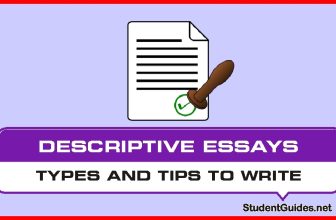
How to Write a Descriptive Essay (Types and Tips)

Narrative Essays: Examples and How to Write them
Leave a reply cancel reply.
Save my name, email, and website in this browser for the next time I comment.
We are a group of language experts, educators, and writers from all over the world who are passionate about education and want to help students succeed without putting them under stress. More About us
About us | > Contact us | > FAQ
Email Sign up

Types of Essay
Definition of types of essay.
An essay is a short academic composition. The word “essay” is derived from a French word “essai” or “essayer,” which mean “trail.” In composition, however, an essay is a piece of non- fiction writing that talks or discusses a specific topic. Presently, essay is part of every degree program.
Each subject has specific requirements for the essays to be written. Some subjects need longer essays, while others need shorter ones, such as a five-paragraph essay. In composition, the start is made from a five-paragraph essay. Based on the requirements, there are seventeen types of essays.
- Definition Essay As the name suggests, a definition type of essay defines different things, ideas, and perceptions.
- Narrative Essay A narrative essay is a narration like a short story . It is, however, different from a short story in that it is written in an essay format.
- Descriptive Essay A descriptive essay describes something to make readers feel, smell, see, taste, or hear what is described.
- Expository Essay An expository essay exposes things in detail to make readers understand without any complications.
- Persuasive Essay A persuasive essay is meant to convince the target audience to do something or not do something.
- Argumentative Essay An argumentative essay is meant to present arguments in the favor of something. It has an additional fourth body paragraph that is meant to present opposite arguments.
- Analytical Essay An analytical essay analyzes something, such as in literature an analytical essay analyzes a piece of literature from different angles.
- Comparison and Contrast Essay A comparison and contrast essay makes either a comparison, a contrast, or both between two different or similar things.
- Cause and Effect Essay A cause and effect essay makes readers understand the cause of things, and their effects on other things.
- Critical Essay A critical essay is written on literary pieces to evaluate them on the basis of their merits or demerits.
- Process Essay A process essay outlines a process of making or breaking or doing something that readers understand fully and are able to do it after reading it.
- Synthesis Essay A synthesis essay means to synthesize different ideas to make a judgement about their merit and demerits.
- Explicatory Essay An explicatory essay is meant to explain a piece of literature. It is often written about poems , short stories, and novels .
- Rhetorical Analysis Essay A rhetorical analysis essay evaluates a speech or a piece of rhetoric on the basis of rhetorical strategies and devices used in it.
- Review Essay A review essay discusses the merits and demerits of a book and evaluates it through a review.
- Simple Essay A simple essay is just a five-paragraph essay that is written on any topic after it is specified.
- Research Essay A research essay revolves around a research question that is meant to answer some specific question through a research of the relevant literature.
Format of an Essay
Generally, a simple a five-paragraph has five paragraphs including an introduction , three body paragraphs, and a conclusion . An argumentative essay, however, has an additional paragraph which presents counter argument or opposing arguments in the same sequence. However, at the end of this paragraph, both the arguments are weighed in the favor of stronger arguments presented earlier in three body paragraphs.
The format of an argumentative essay is given below:
Function of types of essay.
An essay is a specific discussion or debate on a topic from a specific point of view . A student discusses the topic from his own specific angle. Readers not only get a glimpse of what the other aspect of the topic is, they also come to know about the tone and voice of the student writers to decide whether he has achieved a certain level of capability in writing. In literary essays, a writer becomes discusses the influence that literary piece has upon the readers about a certain point of view. Essays are also useful in winning public approval about certain political ideas.
Related posts:
- Seven Types of Ambiguity
- 6 Types of Conflicts in Literature With Examples
- 20 Major Types of Archetypes with Examples
- Four Main Types of Sonnets with Examples
- Elements of an Essay
- Narrative Essay
- Definition Essay
- Descriptive Essay
- Analytical Essay
- Argumentative Essay
- Cause and Effect Essay
- Critical Essay
- Expository Essay
- Persuasive Essay
- Process Essay
- Explicatory Essay
- An Essay on Man: Epistle I
- Comparison and Contrast Essay
Post navigation

- Clerc Center | PK-12 & Outreach
- KDES | PK-8th Grade School (D.C. Metro Area)
- MSSD | 9th-12th Grade School (Nationwide)
- Gallaudet University Regional Centers
- Parent Advocacy App
- K-12 ASL Content Standards
- National Resources
- Youth Programs
- Academic Bowl
- Battle Of The Books
- National Literary Competition
- Youth Debate Bowl
- Youth Esports Series
- Bison Sports Camp
- Discover College and Careers (DC²)
- Financial Wizards
- Immerse Into ASL
- Alumni Relations
- Alumni Association
- Homecoming Weekend
- Class Giving
- Get Tickets / BisonPass
- Sport Calendars
- Cross Country
- Swimming & Diving
- Track & Field
- Indoor Track & Field
- Cheerleading
- Winter Cheerleading
- Human Resources
- Plan a Visit
- Request Info

- Areas of Study
- Accessible Human-Centered Computing
- American Sign Language
- Art and Media Design
- Communication Studies
- Data Science
- Deaf Studies
- Early Intervention Studies Graduate Programs
- Educational Neuroscience
- Hearing, Speech, and Language Sciences
- Information Technology
- International Development
- Interpretation and Translation
- Linguistics
- Mathematics
- Philosophy and Religion
- Physical Education & Recreation
- Public Affairs
- Public Health
- Sexuality and Gender Studies
- Social Work
- Theatre and Dance
- World Languages and Cultures
- B.A. in American Sign Language
- B.A. in Art and Media Design
- B.A. in Biology
- B.A. in Communication Studies
- B.A. in Communication Studies for Online Degree Completion Program
- B.A. in Deaf Studies
- B.A. in Deaf Studies for Online Degree Completion Program
- B.A. in Education with a Specialization in Early Childhood Education
- B.A. in Education with a Specialization in Elementary Education
- B.A. in English
- B.A. in Government
- B.A. in Government with a Specialization in Law
- B.A. in History
- B.A. in Interdisciplinary Spanish
- B.A. in International Studies
- B.A. in Interpretation
- B.A. in Mathematics
- B.A. in Philosophy
- B.A. in Psychology
- B.A. in Psychology for Online Degree Completion Program
- B.A. in Social Work (BSW)
- B.A. in Sociology
- B.A. in Sociology with a concentration in Criminology
- B.A. in Theatre Arts: Production/Performance
- B.A. or B.S. in Education with a Specialization in Secondary Education: Science, English, Mathematics or Social Studies
- B.S in Risk Management and Insurance
- B.S. in Accounting
- B.S. in Accounting for Online Degree Completion Program
- B.S. in Biology
- B.S. in Business Administration
- B.S. in Business Administration for Online Degree Completion Program
- B.S. in Information Technology
- B.S. in Mathematics
- B.S. in Physical Education and Recreation
- B.S. In Public Health
- General Education
- Honors Program
- Peace Corps Prep program
- Self-Directed Major
- M.A. in Counseling: Clinical Mental Health Counseling
- M.A. in Counseling: School Counseling
- M.A. in Deaf Education
- M.A. in Deaf Education Studies
- M.A. in Deaf Studies: Cultural Studies
- M.A. in Deaf Studies: Language and Human Rights
- M.A. in Early Childhood Education and Deaf Education
- M.A. in Early Intervention Studies
- M.A. in Elementary Education and Deaf Education
- M.A. in International Development
- M.A. in Interpretation: Combined Interpreting Practice and Research
- M.A. in Interpretation: Interpreting Research
- M.A. in Linguistics
- M.A. in Secondary Education and Deaf Education
- M.A. in Sign Language Education
- M.S. in Accessible Human-Centered Computing
- M.S. in Speech-Language Pathology
- Master of Social Work (MSW)
- Au.D. in Audiology
- Ed.D. in Transformational Leadership and Administration in Deaf Education
- Ph.D. in Clinical Psychology
- Ph.D. in Critical Studies in the Education of Deaf Learners
- Ph.D. in Hearing, Speech, and Language Sciences
- Ph.D. in Linguistics
- Ph.D. in Translation and Interpreting Studies
- Ph.D. Program in Educational Neuroscience (PEN)
- Individual Courses and Training
- Summer On-Campus Courses
- Summer Online Courses
- Certificates
- Certificate in Sexuality and Gender Studies
- Educating Deaf Students with Disabilities (online, post-bachelor’s)
- American Sign Language and English Bilingual Early Childhood Deaf Education: Birth to 5 (online, post-bachelor’s)
- Peer Mentor Training (low-residency/hybrid, post-bachelor’s)
- Early Intervention Studies Graduate Certificate
- Online Degree Programs
- ODCP Minor in Communication Studies
- ODCP Minor in Deaf Studies
- ODCP Minor in Psychology
- ODCP Minor in Writing
- Online Degree Program General Education Curriculum
- University Capstone Honors for Online Degree Completion Program
Quick Links
- PK-12 & Outreach
- NSO Schedule

Guide to Different Kinds of Essays
202.448-7036
An essay is a paper that discusses, describes or analyzes one topic. It can discuss a subject directly or indirectly, seriously or humorously. It can describe personal opinions, or just report information. An essay can be written from any perspective, but essays are most commonly written in the first person ( I ), or third person (subjects that can be substituted with the he, she, it, or they pronouns).
There are many different kinds of essays. The following are a some of the most common ones:
Descriptive Cause/Effect Argumentative Definition Narrative Critical Compare/Contrast Process
Descriptive:
Examples: A descriptive essay could describe . . .
The descriptive essay provides details about how something looks, feels, tastes, smells, makes one feel, or sounds. It can also describe what something is, or how something happened. These essays generally use a lot of sensory details. The essay could be a list-like description that provides point by point details. Or, it could function as a story, keeping the reader interested in the plot and theme of the event described.
Definition:
Examples: A definition essay may try and define . . .
A definition essay attempts to define a specific term. It could try to pin down the meaning of a specific word, or define an abstract concept. The analysis goes deeper than a simple dictionary definition; it should attempt to explain why the term is defined as such. It could define the term directly, giving no information other than the explanation of the term. Or, it could imply the definition of the term, telling a story that requires the reader to infer the meaning.
Compare/Contrast:
Examples:A compare/contrast essay may discuss . . .
The compare/contrast essay discusses the similarities and differences between two things, people, concepts, places, etc. The essay could be an unbiased discussion, or an attempt to convince the reader of the benefits of one thing, person, or concept. It could also be written simply to entertain the reader, or to arrive at an insight into human nature. The essay could discuss both similarities and differences, or it could just focus on one or the other. A comparison essay usually discusses the similarities between two things, while the contrast essay discusses the differences.
Cause/Effect:
Examples:A cause/effect essay may explain . . .
The cause/effect essay explains why or how some event happened, and what resulted from the event.
This essay is a study of the relationship between two or more events or experiences. The essay could discuss both causes and effects, or it could simply address one or the other. A cause essay usually discusses the reasons why something happened. An effect essay discusses what happens after a specific event or circumstance.
The example below shows a cause essay, one that would explain how and why an event happened.
If this cause essay were about a volcanic eruption, it might go something like this: “Pressure and heat built up beneath the earth’s surface; the effect of this was an enormous volcanic eruption.”
The next example shows an effect essay, one that would explain all the effects that happened after a specific event, like a volcanic eruption.
If this effect essay were about a volcanic eruption again, it might go something like this:
“The eruption caused many terrible things to happen; it destroyed homes, forests, and polluted the atmosphere.”
Examples:A narrative essay could tell of . . .
The narrative essay tells a story. It can also be called a “short story.” Generally, the narrative essay is conversational in style and tells of a personal experience. It is most commonly written in the first person (uses I ). This essay could tell of a single, life-shaping event, or simply a mundane daily experience.
Examples: A process essay may explain . . .
A process essay describes how something is done. It generally explains actions that should be performed in a series. It can explain in detail how to accomplish a specific task, or it can show how an individual came to a certain personal awareness. The essay could be in the form of step-by-step instructions, or in story form, with the instructions/explanations subtly given along the way.
Argumentative:
Examples: An argumentative essay may persuade a reader that . . .
An argumentative essay is one that attempts to persuade the reader to the writer’s point of view. The writer can either be serious or funny, but always tries to convince the reader of the validity of his or her opinion. The essay may argue openly, or it may attempt to subtly persuade the reader by using irony or sarcasm.
Examples: A critical essay may analyze . . .
A critical essay analyzes the strengths, weaknesses, and methods of someone else’s work. Generally, these essays begin with a brief overview of the main points of the text, movie, or piece of art, followed by an analysis of the work’s meaning. It should then discuss how well the author/creator accomplishes his/her goals and makes his/her points. A critical essay can be written about another essay, story, book, poem, movie, or work of art.
202-448-7036
At a Glance
- Quick Facts
- University Leadership
- History & Traditions
- Accreditation
- Consumer Information
- Our 10-Year Vision: The Gallaudet Promise
- Annual Report of Achievements (ARA)
- The Signing Ecosystem
- Not Your Average University
Our Community
- Library & Archives
- Technology Support
- Interpreting Requests
- Ombuds Support
- Health and Wellness Programs
- Profile & Web Edits
Visit Gallaudet
- Explore Our Campus
- Virtual Tour
- Maps & Directions
- Shuttle Bus Schedule
- Kellogg Conference Hotel
- Welcome Center
- National Deaf Life Museum
- Apple Guide Maps
Engage Today
- Work at Gallaudet / Clerc Center
- Social Media Channels
- University Wide Events
- Sponsorship Requests
- Data Requests
- Media Inquiries
- Gallaudet Today Magazine
- Giving at Gallaudet
- Financial Aid
- Registrar’s Office
- Residence Life & Housing
- Safety & Security
- Undergraduate Admissions
- Graduate Admissions
- University Communications
- Clerc Center

Gallaudet University, chartered in 1864, is a private university for deaf and hard of hearing students.
Copyright © 2024 Gallaudet University. All rights reserved.
- Accessibility
- Cookie Consent Notice
- Privacy Policy
- File a Report
800 Florida Avenue NE, Washington, D.C. 20002
Academic Writing

- Introduction
- Writing a Draft
- Revising and Editing
- Thesis statement
- Reference list
- Transitioning Words and Phrases
Types of essays
- Writing pitfalls
- Downloadable Tip Sheets
- Feedback Form
- Co-Curricular Recognition Form
- Faculty Resources
At Sheridan, you are likely to come across four types of essays. Each essay types has different requirements and produces different outcomes. In this section, you will find descriptions of the four essay types: Expository, Argumentative or Persuasive, Reflective, and Descriptive.
Expository Essay
The purpose of an expository essay is to inform, describe, or explain a topic. It requires you to help the reader understand a topic through your own insights and ideas. Using information from credible sources, your essay should provide definitions, facts, explanations, and details about the subject. The essay may also include examples, comparison and contrast and analysis of cause and effect.
Many academic and workplace writing assignments are expository. These topics, for example, often require expository type of writing:
- A medical or biological condition.
- A social or technological process.
- A marketing strategy.
- Life or character of a famous person.
Argumentative or Persuasive Essay
The purpose of an argumentative essay is to persuade readers on a certain point of view, opinion, or position on a topic. It requires you to identify key issues, present the common or existing arguments about the issues, evaluate evidence behind these arguments and argue why your position on the topic is more convincing or stronger than the opposing view. The subject you choose for an argumentative or persuasive essay needs to be debatable.
An argument is an evidence-based opinion supported and explained by sound, credible sources. "To argue in writing is to advance knowledge and ideas in a positive way" (Warkentin & Filipovic, 2019, p. 207). A well-thought-out argument is one that considers facts and various opinions, some of which may be opposing to each other, and analyzes strengths and weaknesses in each. An argumentative essay should not present only evidence on the position you are supporting. It is more convincing when the information presented is not biased towards a position.
Reflective Essay
This type of essay is more personal because you have to consider or "reflect" upon your own experiences and perspectives on the topic you are writing about.
Experiential reflection is commonly assigned in college courses. It involves reflecting on an experience by connecting theory and practice. For example, in an essay about a field placement experience, you may be asked to assess a theory or concept based on your observations and interactions. This type of writing is common in fields such as social work, health care, and business.
Another type of reflective writing involves examining what shapes your perspectives on an issue. The process helps you examine how your thoughts are shaped by your assumptions and environmental factors and may help you understand and appreciate the experiences of other people. Also, you may be challenged to re-examine your preconceived ideas and judgments.
Descriptive Essay
A descriptive essay allows you to describe something, usually an experience, in details so that the reader can get a good impression of it. Similar to the reflective essay, this type of writing is more subjective although information or data from sources may be incorporated to provide more context and support your descriptions. This type of essays tends to be brief. For example, describe an observation in one to two paragraphs.
- Last Updated: Jan 12, 2024 2:29 PM
- URL: https://sheridancollege.libguides.com/AcademicWriting
Connect with us

- school Campus Bookshelves
- menu_book Bookshelves
- perm_media Learning Objects
- login Login
- how_to_reg Request Instructor Account
- hub Instructor Commons
Margin Size
- Download Page (PDF)
- Download Full Book (PDF)
- Periodic Table
- Physics Constants
- Scientific Calculator
- Reference & Cite
- Tools expand_more
- Readability
selected template will load here
This action is not available.

4.3: Types of Essays and Suggested Structures
- Last updated
- Save as PDF
- Page ID 67153
\( \newcommand{\vecs}[1]{\overset { \scriptstyle \rightharpoonup} {\mathbf{#1}} } \)
\( \newcommand{\vecd}[1]{\overset{-\!-\!\rightharpoonup}{\vphantom{a}\smash {#1}}} \)
\( \newcommand{\id}{\mathrm{id}}\) \( \newcommand{\Span}{\mathrm{span}}\)
( \newcommand{\kernel}{\mathrm{null}\,}\) \( \newcommand{\range}{\mathrm{range}\,}\)
\( \newcommand{\RealPart}{\mathrm{Re}}\) \( \newcommand{\ImaginaryPart}{\mathrm{Im}}\)
\( \newcommand{\Argument}{\mathrm{Arg}}\) \( \newcommand{\norm}[1]{\| #1 \|}\)
\( \newcommand{\inner}[2]{\langle #1, #2 \rangle}\)
\( \newcommand{\Span}{\mathrm{span}}\)
\( \newcommand{\id}{\mathrm{id}}\)
\( \newcommand{\kernel}{\mathrm{null}\,}\)
\( \newcommand{\range}{\mathrm{range}\,}\)
\( \newcommand{\RealPart}{\mathrm{Re}}\)
\( \newcommand{\ImaginaryPart}{\mathrm{Im}}\)
\( \newcommand{\Argument}{\mathrm{Arg}}\)
\( \newcommand{\norm}[1]{\| #1 \|}\)
\( \newcommand{\Span}{\mathrm{span}}\) \( \newcommand{\AA}{\unicode[.8,0]{x212B}}\)
\( \newcommand{\vectorA}[1]{\vec{#1}} % arrow\)
\( \newcommand{\vectorAt}[1]{\vec{\text{#1}}} % arrow\)
\( \newcommand{\vectorB}[1]{\overset { \scriptstyle \rightharpoonup} {\mathbf{#1}} } \)
\( \newcommand{\vectorC}[1]{\textbf{#1}} \)
\( \newcommand{\vectorD}[1]{\overrightarrow{#1}} \)
\( \newcommand{\vectorDt}[1]{\overrightarrow{\text{#1}}} \)
\( \newcommand{\vectE}[1]{\overset{-\!-\!\rightharpoonup}{\vphantom{a}\smash{\mathbf {#1}}}} \)
Introduction
The structural organization of an essay will vary, depending on the type of writing task you’ve been assigned. Below are outline templates for specific types of writing projects. Keep in mind these are just a starting point: there is always room for variation and creativity in how a subject is most effectively presented to a reader.
Analytical essay
This is perhaps the most common structure. Examples of this include questions which ask you to discuss , analyze , investigate , explore, or review . In an analytical structure you are required to break the topic into its different components and discuss these in separate paragraphs or sections, demonstrating balance where possible.
- Background information on topic
- Overall point of view of the topic (thesis)
- Overview of components to be discussed (structure)
- Topic sentence outlining first component
- Sentences giving explanations and providing evidence to support topic sentence
- Concluding sentence – link to next paragraph
- Topic sentence outlining second component
- Sentences giving explanations and providing evidence to back topic sentence
- These follow the same structure for as many components as you need to outline
- Summary of the main points of the body
- Restatement of the main point of view
- Justification/evaluation (if required by task)
Argumentative essay
Examples of this type of essay include questions which ask you to take a position on a topic, such as a particular decision or policy, and present arguments which support your position. An effective way to argue a point can be to present the opposing view first then counter this view with stronger evidence.
- Statement of your position on the topic (thesis)
- Overview of arguments to be presented (structure)
- Topic sentence outlining first argument
- Topic sentence outlining second argument
- These follow the same structure for as many arguments as you wish to put forward in support of the topic.
- Restatement of the position
Interpretive essay
Examples of this type of essay include assignments where you are given data such as a case study or scenario, a diagram, graphical information, or a picture and expected to interpret this information to demonstrate your application of knowledge when answering the task. Based on this data, you may be asked to do a range of things such as provide recommendations or solutions, develop a nursing care plan, a teaching plan, suggest legal advice, or plan a marketing strategy.
- Brief background information on topic
- Overview of issues to be addressed in the essay (structure)
- State overall interpretation (thesis)
- Topic sentence outlining first issue identified from the data
- Sentences giving further explanation and providing evidence from both the literature and the data, e.g. the case study to support the topic sentence (it is very important in this types of essays to make reference to the data you have been supplied to give your essay context).
- Topic sentence outlining second issue identified
- These follow the same structure for as many issues as you wish to discuss from the data you have been supplied.
- Statement of overall interpretation
- Summary of the main issues from the data supplied
- Make recommendations or suggest solutions to address the issues arising from the data supplied.
Comparative essay
Examples of this type of essay include compare , compare and contrast , or differentiate questions. In this structure the similarities and/or differences between two or more items (for example, theories or models) are discussed paragraph by paragraph. Your assignment task may require you to make a recommendation about the suitability of the items you are comparing.
- Outline of two (or more) things being compared or contrasted
- Purpose for making the comparison / contrast
- Overview of the specific points to be compared / contrasted
- Topic sentence outlining first similarity or difference
- Topic sentence outlining second similarity or different
- These follow the same structure for as many items or aspects as you need to compare/contrast
- Restatement of the main purpose for the comparison / contrast
- Summary of the main similarities and differences
- Recommendation about suitability of compared items for purpose (if requirement of assessment task)
- Overall conclusion
Problem and solution essay
These essay questions often require you to structure your answer in several parts. An example may be to ask you to investigate a problem and explore a range of solutions. You may also be asked to choose the best solution and justify your selection, so allow space for this in your essay if needed.
- Background information about the problem
- Description of the problem and why it is serious
- Overview of the solutions to be outlined
- Topic sentence outlining first solution
- Explanation of the positive and negative aspects of the solution
- Evidence to support explanations
- Concluding sentence
- Topic sentence outlining second solution
- Evidence to support explanation
- These follow the same structure for as many solutions as you need to discuss
- Summary of the problem and overview of the solutions
- Evaluation of solutions and recommendation of best option
Note : Depending on the topic, body paragraphs in a problem and solution essay could be devoted to discussing the problem in more detail, as well as the solution. It’s up to the writer to assess the needs of the project, in order to decide how much time is spent on each part.
Cause and effect essay
Examples of this type of essay include questions which ask you to state or investigate the effects or outline the causes of the topic. This may be, for example, an historical event, the implementation of a policy, a medical condition, or a natural disaster. These essays may be structured in one of two ways: either the causes(s) of a situation may be discussed first followed by the effect(s), or the effect(s) could come first with the discussion working back to outline the cause(s). Sometimes with cause and effect essays you are required to give an assessment of the overall effects, such as on a community, a workplace, an individual. Space must be allocated for this assessment in your structure if needed.
- Background information on situation under discussion
- Description of the situation
- Overview of the causes or effects to be outlined
- Topic sentence outlining first cause or effect
- Sentences giving explanations and providing evidence to support the topic sentence
- Concluding sentence – linking to next paragraph
- Topic sentence outlining second cause or effect
- These follow the same structure for as many causes or effects as you need to outline
- Conclusion, prediction or recommendation
Finally, consider that some essay assignments may ask you to combine approaches, especially in more advanced classes. At that point, you may have to vary your body paragraph strategy from section to section.
This chart gives an idea of what different roles paragraphs can play in a mixed-structure essay assignment.
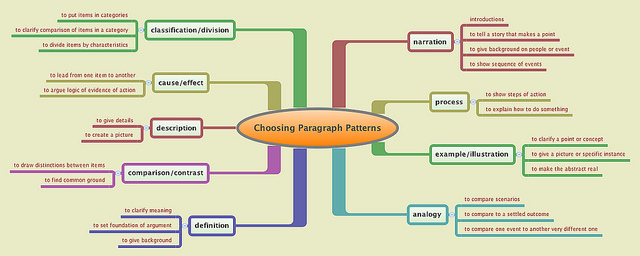
Figure \(\PageIndex{1}\)
- Our Writers
- How to Order
- Assignment Writing Service
- Report Writing Service
- Buy Coursework
- Dissertation Writing Service
- Research Paper Writing Service
- All Essay Services
- Buy Research Paper
- Buy Term Paper
- Buy Dissertation
- Buy Case study
- Buy Presentation
- Buy Personal statement
Essay Writing Guide
Types Of Essay
Explore Different Types of Essays, their Purpose, and Sub-types
11 min read

People also read
An Easy Guide to Writing an Essay
Learn How to Write An Essay in Simple Steps
A Complete 500 Word Essay Writing Guide
A Catalog of 500+ Essay Topics for Students
Essay Format: A Basic Guide With Examples
Learn How to Create a Perfect Essay Outline
How to Start an Essay- A Step-by-Step Guide
A Complete Essay Introduction Writing Guide With Examples
Learn How to Write an Essay Hook, With Examples
The Ultimate Guide to Writing Powerful Thesis Statement
20+ Thesis Statement Examples for Different Types of Essays?
How to Write a Topic Sentence: Purpose, Tips & Examples
Learn How to Write a Conclusion in Simple Steps
Transition Words For Essays - The Ultimate List
4 Types of Sentences - Definition & Examples
Writing Conventions - Definition, Tips & Examples
Essay Writing Problems - 5 Most Paralyzing Problems
How to Make an Essay Longer: 14 Easy Ways
How to Title an Essay - A Detailed Guide
1000 Word Essay - A Simple Guide With Examples
Are you a college or high school student ready to start on a journey through the fascinating world of essay writing ? Brace yourself because you'll encounter a variety of essay types that will challenge your writing skills and creativity.
Picture this: You're handed an assignment, a blank canvas on which to express your thoughts and ideas. But here's the catch – your teacher won't always specify the type of essay you should craft. It's up to you to solve the riddle hidden within the assignment question.
But fear not!
In this blog, we'll discuss the four most common types of essays you're likely to encounter during your academic years. While these essays may share a common foundation and structure, each possesses its own unique characteristics. Let’s get started!
- 1. Major Types of Essays In Academic Writing
- 2. Argumentative Essay
- 3. Descriptive Essay
- 4. Expository Essay
- 5. Narrative Essay
- 6. Other Essay Types
Major Types of Essays In Academic Writing
When it comes to academic writing, understanding the different types of essays is essential. Each type serves a distinct purpose and requires a specific approach. Let's explore these essay types along with their descriptions and example prompts in the table below:
Understanding these major types of essays and the skills they assess will empower you to approach your academic writing with confidence. Depending on your assignment's requirements, you'll be better equipped to choose the appropriate essay type and showcase your writing abilities effectively.
Each type offers a unique opportunity for you to express your ideas, and arguments and perfect your specific writing skills.
Here are the key types of essay formats explained in detail, along with examples to enhance your understanding.

Paper Due? Why Suffer? That's our Job!
Argumentative Essay
An argumentative essay is an essay type that presents a well-structured argument supported by evidence and reasoning. The primary goal is to engage the reader in a discussion, provide evidence, and logically demonstrate why a particular viewpoint is more valid.
In simple words, the writer must provide evidence and remain consistent in their stance. While argumentative essays present both sides of an issue, they strongly support one perspective.
Characteristics of Argumentative Essay
- Clear Thesis: It should have a clear thesis statement to state the writer's position.
- Balanced Presentation: An argumentative essay addresses opposing views.
- Evidence: It relies on credible and relevant evidence.
- Logical Reasoning: The essay presents arguments coherently and logically.
- Persuasive Techniques: It uses persuasive techniques like ethos, pathos, and logos effectively.
- Introduction: The introduction introduces the topic and thesis, engaging the reader's interest.
- Body: The body paragraphs present arguments with supporting evidence.
- Counterargument: It addresses opposing viewpoints and refutes them.
- Conclusion: The conclusion summarizes key points and reinforces the thesis, leaving a strong impression.
Argumentative Essay Example
Before beginning the writing process, it is better to go through some expertly crafted argumentative essay examples . This approach enables you to grasp the argumentative essay outline and writing style more effectively.
Descriptive Essay
A descriptive essay is a form of writing that aims to immerse readers in a sensory-rich experience. Unlike informational or persuasive essays, its primary goal is to vividly depict a person, place, object, event, or experience. The descriptive essay must evoke the senses and emotions of the reader. In simple terms, the reader should see what you saw and feel what you felt. To make it better, you can use several literary devices such as;
- Alliteration
All of them help in making the experience and your essay better.
Key Characteristics
- Sensory Detail: Descriptive essays appeal to the five senses to create a multisensory experience.
- Vivid Imagery: They use figurative language and descriptive adjectives to bring the narrative to life.
- Emotional Connection: These essays often aim to establish an emotional bond between the reader and the subject.
- Structured Approach: They typically follow an introduction-body-conclusion structure.
- Introduction: Introduces the subject and purpose, sometimes with a thesis statement.
- Body Paragraphs: Focus on specific aspects or details using sensory language and vivid descriptions.
- Conclusion: Summarizes the central theme and leaves a lasting impression.
Descriptive Essay Example
Creating a perfect descriptive essay for an assignment is not difficult if you go through some expert descriptive essay examples first.
Need more examples? Read our Descriptive Essay Examples and Writing Tips blog to get inspired!
Expository Essay
An expository essay is a type of writing that provides clear and objective explanations of a topic without expressing personal opinions. It aims to inform and educate by presenting factual information and analysis.
Therefore, it is important that you make a focused outline and stick to it throughout the process.
An expository essay incorporates a wide array of essays such as:
- Cause and effect essays
- Process essays
- Analytical essays
- Compare and contrast essays
Key Characteristics
- Objective Presentation: Expository writing maintains an impartial tone, avoiding personal biases.
- Informativeness: They focus on explaining complex ideas or processes in a straightforward manner.
- Structured: These essays follow a clear structure with an introduction, body paragraphs, and a conclusion.
- Use of Evidence: They rely on credible evidence, facts, and examples to support the topic.
- Introduction: Introduces the topic and often includes a thesis statement.
- Body Paragraphs: Each paragraph focuses on a specific aspect and provides explanations and evidence.
- Conclusion: Restates the main idea and summarizes key points.
Expository Essay Example
Looking for more sample essays? Check out our Expository Essay Examples blog and take inspiration from a range of expository essays!
Narrative Essay
A narrative essay is a type of academic writing that tells a story or recounts a personal experience. Unlike other essays, its primary purpose is to engage and entertain the reader through storytelling.
- Narrative Structure: Follows a chronological sequence with an introduction, body, climax, and conclusion.
- First-Person Perspective: Typically written from the first-person point of view (e.g., "I" and "we") , sharing personal experiences and emotions.
- Vivid Description: Relies on descriptive language and imagery to create a clear picture of events, characters, and settings.
- Emotional Connection: Aims to establish an emotional bond with the reader by conveying the writer's thoughts and feelings.
- Introduction: Sets the stage and introduces the central theme or problem.
- Body: Presents events or experiences in chronological order with sensory details.
- Climax: Often includes a central event or turning point.
- Conclusion: Reflects on the narrative, offering insights, lessons, or resolution.
Narrative Essay Example
Wondering how to get your story into an interesting narrative? Learn the best way to write a perfect narrative essay with the help of expert narrative essay examples.
For more examples visit our blog on narrative essay examples .
Tough Essay Due? Hire Tough Writers!
Other Essay Types
In addition to the major types of essays discussed earlier, there are several other specialized types that cater to specific audiences. These essays provide diverse avenues for writers to communicate their ideas effectively.
We will go through these essay types here.
Persuasive Essay
A persuasive essay is another type of academic essay. In this essay type, the writer utilizes logic and reasoning to show one’s idea is more convincing than another idea.
In writing a persuasive essay, the main aim is to persuade the reader to accept a certain point of view. The presented argument or claim must use solid evidence and sound reasoning by stating facts, examples, and quotes.
Persuasive Essay Example
Since persuasive essays are the most common type of essay, it is essential to get familiar with their writing style. For that, here is an interesting persuasive essay example that you can explore for your better understanding.
Read our persuasive essay examples blog for more samples!
Analytical Essay
An analytical essay is a type of academic essay in which the writer analyzes a topic bit by bit. Writing an analytical essay is not about convincing readers of your point of view. But wanting readers to agree with what you have written.
So, there is no need to use strong persuasive language in an analytical essay. Rather you should aim to provide enough analysis to make sure your argument is clear to the readers.
Analytical Essay Example
Let’s take a look at a sample analytical essay:
Read our analytical essay examples blog if you are looking for more sample essays!
Reflective Essay
A reflective essay type of essay requires you to examine your personal experiences through self-reflection. In the process of writing a reflective essay, you provide insight into what you have gained from those experiences.
What makes reflective essays different from other essay types is the fact that it examine the past experience from the present. Reflective essays take the reader through a journey of self-growth.
Reflective Essay Example
The following reflective essay example will help you get a clear idea of how to structure your analytical essay.
Rhetorical Analysis Essay
It is a form of a textual analysis essay in which the student examines and analyzes a persuasive text. It is like an essay, speech, or visual art and analyzes the rhetorical devices used in it. Writing a rhetorical analysis essay is different from writing other essays because it will be more than adding facts only.
Rhetorical Analysis Essay Example
Here is a rhetorical analysis essay example that will help you learn better.
Check out our rhetorical analysis essay examples blog for more samples!
Literary Analysis Essay
A literary analysis essay is based on close reading and analysis of a work of literature like poetry and novel. It identifies different literary factors like themes, setting, characters, setting, and the kind of language used in it. A literary analysis essay has the same 5 paragraphs as any other essay but the main subject and topic are different.
Literary Analysis Essay Example
Need help with your literary analysis essay? Below is a sample essay to help you understand better.
Summing it Up! Now you know what are the different types of essays in academic writing that you are most likely to get assigned. However, if you still find it difficult to compose your essay, leave your piece of writing to our experts.
Whether you need an argumentative essay, narrative essay, descriptive essay, or expository essay we are here to help. Our expertise extends to all types of essays, ensuring that your academic writing needs are met with precision and excellence.
Request essay help today and let our experts assist you in writing A+ grade essays within your specified timeline!
Frequently Asked Questions
What is the most important element in any essay.
A thesis statement is the most important part of any essay. Other than the research itself, the thesis statement is the most important part of an essay or research paper. A thesis statement summarizes the main point and essence of the argument.
What type of essay is most common at university?
Usually, university students get argumentative kinds of essays. No matter what kind of essay you write, you will need to develop an argument.
Here are some kinds of essays and the kind of arguments added to them.
- Analysis and interpretation of literary texts are discussed in literary analysis essays.
- The importance of a particular event or theory is analyzed in a history argumentative essay.
- A political theory is examined in a political argumentative essay.
Besides, there are a number of different kinds of argumentative and analysis essays.

Write Essay Within 60 Seconds!

Nova Allison is a Digital Content Strategist with over eight years of experience. Nova has also worked as a technical and scientific writer. She is majorly involved in developing and reviewing online content plans that engage and resonate with audiences. Nova has a passion for writing that engages and informs her readers.

Paper Due? Why Suffer? That’s our Job!
Keep reading

- Link to facebook
- Link to linkedin
- Link to twitter
- Link to youtube
- Writing Tips
Essay Tips: Four Types of Essay
3-minute read
- 25th March 2019
Every essay is different. But we can identify four common types of essay:
- Expository essays (i.e., essays that explain something)
- Descriptive essays (i.e., essays that describe something)
- Persuasive essays (i.e., essays that aim to persuade the reader)
- Narrative essays (i.e., essays that tell a story)
These are not always clear distinctions (e.g., a narrative essay may also be descriptive). Nevertheless, most essays fall into one of the categories above, and knowing the differences between them can be useful when planning your work . Read on to find out more.
1. Expository Essays
Expository essays focus on explaining something. The aim is to test how well you can communicate your understanding of a topic. This often involves comparing and contrasting two ideas, or defining something and giving an example. Expository essays are typically structured as follows:
- An introduction that sets out the subject matter, how you will answer the essay question, and any key background information.
- A series of logically connected paragraphs setting out your understanding of the subject, along with evidence to support your claims.
- A conclusion that addresses your essay question.
This type of essay is often used for shorter assignments and exams.
2. Descriptive Essays
Descriptive essays are less about arguing a point and more about creating a detailed picture. The problem is that you need to create this picture with words! These essays are sometimes quite personal or creative (e.g., reflective essays often include a descriptive element). However, they should still be clearly structured and written to make them easy to follow.
Your aim should be to leave your reader with a clear idea of what you are describing. This is a very useful skill to have in any form of writing, in fact, as it will make your work more compelling.
3. Persuasive Essays
Persuasive (or argumentative ) essays are a lot like expository essays. They are often structured similarly, for example. And both types of essay ask you to answer a question via research.
Find this useful?
Subscribe to our newsletter and get writing tips from our editors straight to your inbox.
However, a persuasive essay is also about presenting a thesis and backing it up with evidence or arguments. For example, rather than just setting out and comparing two theories, for a persuasive essay, you might need to research different aspects of these theories, address them critically, and argue for one over the other. This may involve in-depth research or an experiment.
As such, persuasive essays are usually longer than expository essays. They are often used as end-of-module assignments in colleges, too.
4. Narrative Essays
Finally, narrative essays tell a story. This doesn’t mean that you have to write your essay as a short story, but it will draw on the conventions of storytelling.
In terms of content, narrative essays are usually quite personal or anecdotal, but they should also have a point (a moral to the story or a lesson that you have learned from an experience).
The language used in a narrative essay should be clear and concise, but it will also be descriptive and emotive. Using the first-person pronoun “I” is much more common in this type of essay than others, too, as you will often be writing about your own experiences.
Finally, whatever type of essay you are writing, don’t forget that having your work proofread is a great way to boost your marks.
Share this article:
Post A New Comment
Got content that needs a quick turnaround? Let us polish your work. Explore our editorial business services.
9-minute read
How to Use Infographics to Boost Your Presentation
Is your content getting noticed? Capturing and maintaining an audience’s attention is a challenge when...
8-minute read
Why Interactive PDFs Are Better for Engagement
Are you looking to enhance engagement and captivate your audience through your professional documents? Interactive...
7-minute read
Seven Key Strategies for Voice Search Optimization
Voice search optimization is rapidly shaping the digital landscape, requiring content professionals to adapt their...
4-minute read
Five Creative Ways to Showcase Your Digital Portfolio
Are you a creative freelancer looking to make a lasting impression on potential clients or...
How to Ace Slack Messaging for Contractors and Freelancers
Effective professional communication is an important skill for contractors and freelancers navigating remote work environments....
How to Insert a Text Box in a Google Doc
Google Docs is a powerful collaborative tool, and mastering its features can significantly enhance your...

Make sure your writing is the best it can be with our expert English proofreading and editing.

- Customer Reviews
- Extended Essays
- IB Internal Assessment
- Theory of Knowledge
- Literature Review
- Dissertations
- Essay Writing
- Research Writing
- Assignment Help
- Capstone Projects
- College Application
- Online Class
9 Different Types of Essays: The Complete List Explained
by Antony W
May 31, 2024
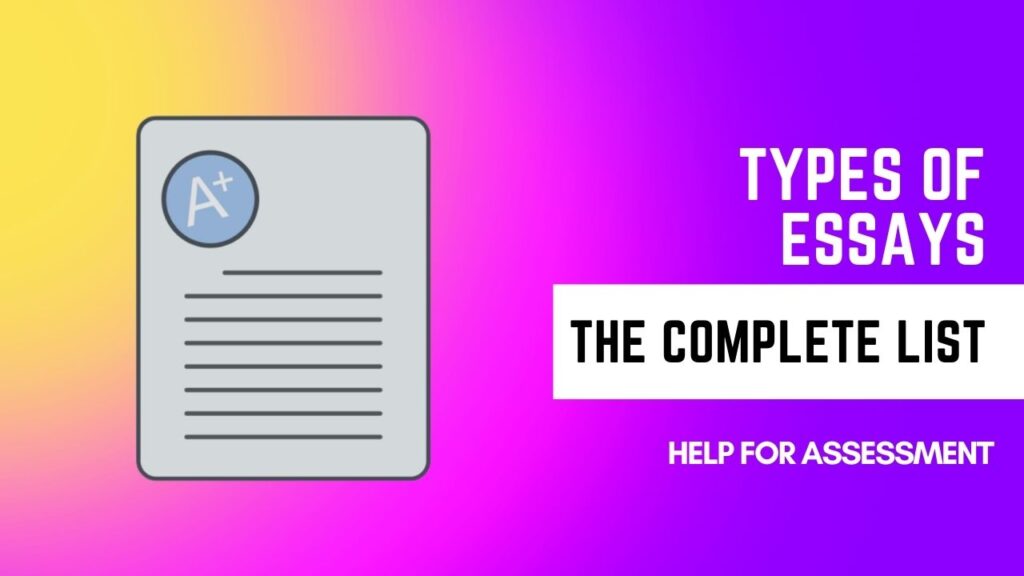
You will write more than one types of essays before and after joining college. So it’s important to know which ones they’re and their significance.
Key Takeaways
The types of essays you’ll write in college or university are as follows:
- Admissions Essay
- Argumentative Essay
- Cause and effect Essay
- Scholarship Essay
- Persuasive Essay
- Explanatory Essay
- Theory of Knowledge Essay
- Thematic Essay
In this guide, we discuss each of these types of essays, not to mention point you to the resourceful guides that we’ve put together to teach you exactly how to write these essays.
Some of these essays are long and some have flexible word count, which mean you can make them longer if it’s necessary to do so.
To be abundantly clear, this guide isn’t about how to write each types of essays in college. It’s a highlight of the different types of essays.
Note that we’ve included, where possible, links to resources you can use as the definitive guide to write a specific type of an essay.
What Are The Different Types of Essays in Academic Writing?
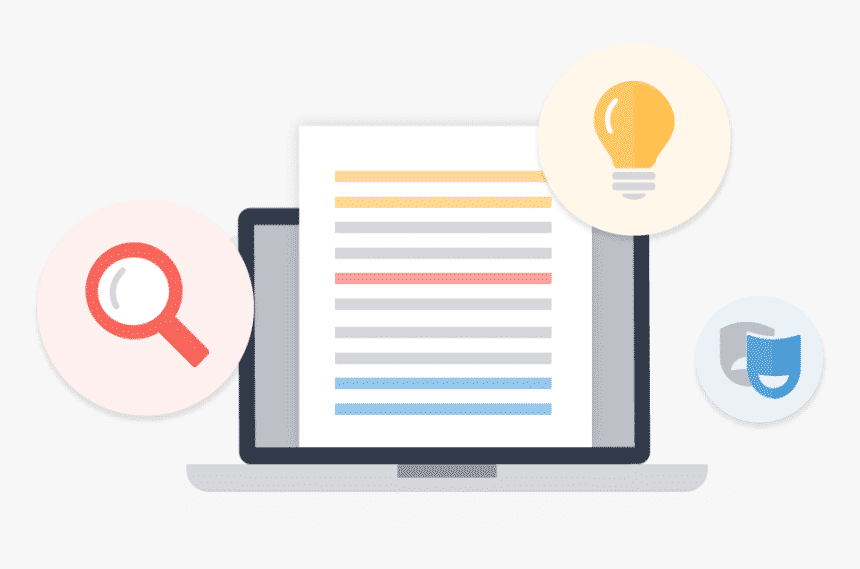
We’ve classified the types of essays into those you will do before joining college and those you will write once you’re in college.
1. Admission Essay
Also known as an application essay, an admissions essay is an assignment you write if you want to join a college or a university.
The essay tells a college admissions committee more about you in a much better way that your results transcript does.
The goal of the essay is to communicate unique characters about yourself and to convince an admission committee that you’re a good fit for their institution.
Depending on the admission criteria of the college or university you choose, you may have to submit the essay along with a personal statement. In most cases, an admissions essay is often more than enough.
If you need help to write a comprehensive and convincing admissions essay, hire our admission essay writing service here . Our team will help you write a high quality essay guaranteed to win you an admission in a college of your choice.
You may also be interested in learning about writing an MBA essay if you’re looking forward to enrolling in a school of Management in Business Administration.
2. Argumentative Essay
Argumentative essays are debatable in nature.
You have to take a stance on an issue and then use evidence to justify your claims and defend your position.
In addition to sharing your point of view, you also anticipate counterclaims, which is the opposite of exactly what you believe to be right. Then you have to give a rebuttal to the opposing point of view.
There’s a lot you need to know about argumentative essays, so we’ve put together a hub to guide you. Click here for more.
3. Cause and Effect Essay
A cause and effective essay is argumentative in nature. It examines the relationships between two subjects, which can be a thing, an idea, a person, or an event.
The work of the writer is to determine how these subjects directly influence one another.
4. Scholarship Essay
The purpose of a scholarship essay is to convince a target audience that you qualify for a respective scholarship program.
For the essay to stand out from the many options from other candidates, you have to pay close attention to details and provide the information that the administration requires.
When writing a scholarship essay, it’s important to describe your personal experiences, your personalities, the event that have changed you, and the people that have made a bigger impact in your life.
5. Persuasive Essay
A persuasive essay is an assignment written to shift perspective and bring positive change.
With this essay, you present your stand to your reader and give them all the reasons why they should consider and even share your thoughts.
If you believe that marijuana should be legalized in Africa or abortion should be illegal in America, your essay had better convince people to consider your beliefs.
You should not confuse a persuasive essay with an argumentative essay. The aim of the former presents only one side of an issue and convinces an audience to accept certain ideas.
To learn more about persuasive essay, including how to write it, see this guide .
6. Explanatory Essay
Instead of being argumentative in form, an explanatory essay only requires you to look into an issue and give your opinion, even if you don’t agree with the author or your very own point of view.
You only have to make sure that you’ve done your research and that your point of view on the subject is logical.
The goal of this essay isn’t to prove a point. The aim with it is to make it easier for your audience to understand what the issue is.
For a more comprehensive guide on an explanatory essay, check this guide .
7. Theory of Knowledge Essay
A Theory of Knowledge essay is an individual task completed by students who have enrolled in the IB diploma program.
Mandatory for all IB students and moderated externally, this essay is 1,600 words long and account for two thirds of the overall TOK marks.
The other one third goes to the TOK Exhibition commentary .
You don’t choose a topic to explore in this essay.
IB provides it for you in a list of prescribed titles , which changes every exam season.
The purpose of the TOK essay assignment is to gauge your ability to provide clarity of argument.
8. Theology Essay
In writing a theology paper , students have to analyze the different types of religion and the expression of human faith across different cultures.
Given the impact religion has on societies, even people who aren’t profoundly religious will find this type of an essay quite interesting to explore.
9. Thematic Essay
Also known as a theme essay, thematic essays identify an idea in a literary object followed by an exploration of how the author addresses the themes using different literary devices.
The devices used in a thematic essay can be allegory, hyperbole, metaphors, or imageries. Work on a thematic essay can be on a magazine article, an audio, a video, a book, or a speech.
While a thematic essay should be five paragraphs by default, you can make it longer depending on how complex the assignment is.
About the author
Antony W is a professional writer and coach at Help for Assessment. He spends countless hours every day researching and writing great content filled with expert advice on how to write engaging essays, research papers, and assignments.
The 4 Different Types of Essays
Let’s face it. At some point in your life, you will be required to write an essay — whether for a school homework, college standardized tests or even for work-related purposes.
There are several basic types of essays to choose from, the most common are expository, narrative, persuasive and analytical. Which one you choose really depends on your objectives. We'll explore each type in depth, and offer recommendations on the typical word counts for each essay type.

Expository Essay
An expository essay gives a brief explanation of an issue, idea or theme. Purdue OWL expands on this, offering some common requirements in step form: investigation of an idea, evaluation of evidence, a systematic and detailed explanation of the idea, and a clear and concise statement of an argument about the idea.
Because brevity is required for this type of essay, the recommended length is around 500-800 words.
In order to be effective, an expository essay should possess:
- A clear-cut thesis statement, research question, or statement of intent
- A no-frills approach to answering the question or addressing your thesis - factual evidence to support your claim or position
- Conciseness
The first paragraph of an expository essay should be the shortest since it only seeks to briefly yet clearly state your thesis, research question, or intent. A maximum of 200 words should suffice.
Now, the succeeding paragraphs will be VERY crucial because they should contain all the necessary details to support your thesis statement. That means they would require a bigger chunk of your word count. But remember to still keep them succinct — no- frills, factual, and straightforward.
Finally, the last paragraph will serve as your conclusion to tie it all together. Emphasize your point but don’t dwell on it too much.
Narrative Essay
A narrative essay is all about the storytelling of real-life experiences. This essay type usually relays a personal or experiential account and uses a first-person point-of-view. Any story requires a beginning, middle and end — a narrative essay should be structured in the same way.
According to Essay Info a narrative essay possesses the following qualities:
- It is usually written with a first-person point-of-view
- It contains vivid imagery and sensory details
- It has all the essential elements of a story (i.e. plot, theme, character, setting, style, tone, etc.)
Because descriptive and evocative language is needed for this type of essay, around 1,000 words may be required at the least in order to tell a full-bodied story. Think of a narrative essay as a short version of a novel — each paragraph represents a “chapter” in the story.
Make your essay riveting by adding anecdotes or dialogues into the narrative. Most importantly, end your essay with a conclusion or a personal statement — a takeaway will make your story more memorable to the reader.
Persuasive Essay
A persuasive essay (also referred to as an argumentative essay) makes use of logical reasoning to influence the reader to adopt the writer’s point of view. This essay type works harder compared to other essay types because the writer needs to convince the reader to espouse his position. In order to be eloquent and convincing, a definitive rationale or argument is imperative.
The qualities of a persuasive essay include:
- Factual evidence
- Valid reasoning
- Sustaining the reader’s interest
- A natural progression from one idea to the next - a forceful and convincing conclusion
To create a compelling argument, Scribbr advises an essay length of about 2,500 words . Anything under 2,000 words may be construed as “under-explaining” your point. However, your essay should go beyond just meeting the required length. Your writing should still be concise, on-point and progressive. Avoid fluff or fillers because they will only digress from the topic and may discredit your argument altogether.
Scribbr also provides some useful tips on how to structure paragraphs. It is important for paragraphs “to support a single claim or idea that helps establish the overall argument or purpose of the paper.”
To be able to achieve this, having a topic sentence for every paragraph will be helpful. However, the core of a persuasive essay is its ability to provide substantial evidence to support one’s argument. Additionally, the use of transitional devices will make your sentences more coherent and cohesive.

Analytical Essay
An analytical essay requires the presentation of an argument or claim by breaking down and examining the core components of an issue, idea, or works of art such as films, books, paintings, etc.
Some of its characteristics include:
- An introduction and presentation of argument to highlight the text in the literary work which you will be deliberating about
- An analysis of said text which should be relevant to your argument as well as your own take on whether the author’s goals were met or not supported by examples
- A personal response to demonstrate your in-depth comprehension of the text in formulating your opinion — whether positive or negative
A literary analysis essay can be from 500-700 words. For as long as it covers all the principal points, it need not be lengthy. However, the bulk of your essay should concentrate on the analysis of the text.
Bucks Community College elaborates on these three principles to help you write an essay that has “tight organization and control.”
- Your writing “must stick with great determination to the specific point of development”
- Your essay should have a central idea or thesis that will dictate its development
- Your writing should be systematic and organized such that every paragraph aids the reader to have a deeper understanding of your central idea
Here are some other helpful tips to guide you through writing an analytical essay:
- Always write in the present tense
- Avoid using contractions and informal language or colloquialisms
- Avoid writing in the first person
- Analyze, don’t retell the story
- Be critical — your personal response need not be positive
Now that you have a clearer idea of the different types of essays and how to go about each of them, it’s time to start writing one. Make sure to use our word counter to keep it succinct.
How to Write Essay Titles and Headers
Don’t overlook the title and section headers when putting together your next writing assignment. Follow these pointers for keeping your writing organized and effective.
101 Standout Argumentative Essay Topic Ideas
Need a topic for your upcoming argumentative essay? We've got 100 helpful prompts to help you get kickstarted on your next writing assignment.
Writing a Standout College Admissions Essay
Your personal statement is arguably the most important part of your college application. Follow these guidelines for an exceptional admissions essay.
Purdue Online Writing Lab Purdue OWL® College of Liberal Arts
Welcome to the Purdue Online Writing Lab

Welcome to the Purdue OWL
This page is brought to you by the OWL at Purdue University. When printing this page, you must include the entire legal notice.
Copyright ©1995-2018 by The Writing Lab & The OWL at Purdue and Purdue University. All rights reserved. This material may not be published, reproduced, broadcast, rewritten, or redistributed without permission. Use of this site constitutes acceptance of our terms and conditions of fair use.
The Online Writing Lab at Purdue University houses writing resources and instructional material, and we provide these as a free service of the Writing Lab at Purdue. Students, members of the community, and users worldwide will find information to assist with many writing projects. Teachers and trainers may use this material for in-class and out-of-class instruction.
The Purdue On-Campus Writing Lab and Purdue Online Writing Lab assist clients in their development as writers—no matter what their skill level—with on-campus consultations, online participation, and community engagement. The Purdue Writing Lab serves the Purdue, West Lafayette, campus and coordinates with local literacy initiatives. The Purdue OWL offers global support through online reference materials and services.
A Message From the Assistant Director of Content Development
The Purdue OWL® is committed to supporting students, instructors, and writers by offering a wide range of resources that are developed and revised with them in mind. To do this, the OWL team is always exploring possibilties for a better design, allowing accessibility and user experience to guide our process. As the OWL undergoes some changes, we welcome your feedback and suggestions by email at any time.
Please don't hesitate to contact us via our contact page if you have any questions or comments.
All the best,
Social Media
Facebook twitter.
26 Types of Punctuation Marks & Typographical Symbols
- What Is Punctuation?
- What Is A Typographical Symbol?
- Punctuation Vs. Typographical Symbols
- Types Of Punctuation And Symbols
- Try Grammar Coach
We use words in writing. Shocking, I know! Do you know what else we use in writing? Here is a hint: they have already appeared in this paragraph. In addition to words, we use many different symbols and characters to organize our thoughts and make text easier to read. All of these symbols come in two major categories: punctuation marks and typographical symbols . These symbols have many different uses and include everything from the humble period ( . ) to the rarely used caret symbol ( ^ ). There may even be a few symbols out there that you’ve never even heard of before that leave you scratching your head when you see them on your keyboard!
What is punctuation ?
Punctuation is the act or system of using specific marks or symbols in writing to separate different elements from each other or to make writing more clear. Punctuation is used in English and the other languages that use the Latin alphabet. Many other writing systems also use punctuation, too. Thanks to punctuation, we don’t have to suffer through a block of text that looks like this:
- My favorite color is red do you like red red is great my sister likes green she always says green is the color of champions regardless of which color is better we both agree that no one likes salmon which is a fish and not a color seriously
Punctuation examples
The following sentences give examples of the many different punctuation marks that we use:
- My dog , Bark Scruffalo , was featured in a superhero movie .
- If there ’ s something strange in your neighborhood , who are you going to call ?
- A wise man once said , “ Within the body of every person lies a skeleton .”
- Hooray ! I found everything on the map : the lake , the mountain , and the forest .
- I told Ashley ( if that was her real name ) that I needed the copy lickety-split .
What is a typographical symbol ?
The term typographical symbol , or any other number of phrases, refers to a character or symbol that isn’t considered to be a punctuation mark but may still be used in writing for various purposes. Typographical symbols are generally avoided in formal writing under most circumstances. However, you may see typographic symbols used quite a bit in informal writing.
Typographical symbol examples
The following examples show some ways that a writer might use typographical symbols. Keep in mind that some of these sentences may not be considered appropriate in formal writing.
- The frustrated actor said she was tired of her co-star’s “annoying bull **** .”
- For questions, email us at anascabana @ bananacabanas.fake!
- The band had five # 1 singles on the American music charts during the 1990s.
- My internet provider is AT & T.
⚡️ Punctuation vs. typographical symbols
Punctuation marks are considered part of grammar and often have well-established rules for how to use them properly. For example, the rules of proper grammar state that a letter after a period should be capitalized and that a comma must be used before a coordinating conjunction.
Typographical symbols, on the other hand, may not have widely accepted rules for how, or even when, they should be used. Generally speaking, most grammar resources will only allow the use of typographical symbols under very specific circumstances and will otherwise advise a writer to avoid using them.
Types of punctuation and symbols
There are many different types of punctuation marks and typographical symbols. We’ll briefly touch on them now, but you can learn more about these characters by checking out the links in this list and also each section below:
- Question mark
- Exclamation point
- Parentheses
- Square brackets
- Curly brackets
- Angle brackets
- Quotation marks
- Bullet point
- Pound symbol
- Caret symbol
- Pipe symbol
Period, question mark, and exclamation point
These three commonly used punctuation marks are used for the same reason: to end an independent thought.
A period is used to end a declarative sentence . A period indicates that a sentence is finished.
- Today is Friday .
Unique to them, periods are also often used in abbreviations.
- Prof . Dumbledore once again awarded a ludicrous amount of points to Gryffindor.
Question mark (?)
The question mark is used to end a question, also known as an interrogative sentence .
- Do you feel lucky ?
Exclamation point (!)
The exclamation point is used at the end of exclamations and interjections .
- Our house is haunted !
Comma, colon, and semicolon
Commas, colons, and semicolons can all be used to connect sentences together.
The comma is often the punctuation mark that gives writers the most problems. It has many different uses and often requires good knowledge of grammar to avoid making mistakes when using it. Some common uses of the comma include:
- Joining clauses: Mario loves Peach , and she loves him .
- Nonrestrictive elements: My favorite team , the Fighting Mongooses , won the championship this year.
- Lists: The flag was red , white , and blue.
- Coordinate adjectives: The cute , happy puppy licked my hand.
Try out this quiz on the Oxford comma!
The colon is typically used to introduce additional information.
- The detective had three suspects : the salesman, the gardener, and the lawyer.
Like commas, colons can also connect clauses together.
- We forgot to ask the most important question : who was buying lunch?
Colons have a few other uses, too.
- The meeting starts at 8:15 p.m.
- The priest started reading from Mark 3:6 .
Semicolon (;)
Like the comma and the colon, the semicolon is used to connect sentences together. The semicolon typically indicates that the second sentence is closely related to the one before it.
- I can’t eat peanuts ; I am highly allergic to them.
- Lucy loves to eat all kinds of sweets ; lollipops are her favorite.
Hyphen and dashes (en dash and em dash)
All three of these punctuation marks are often referred to as “dashes.” However, they are all used for entirely different reasons.
The hyphen is used to form compound words.
- I went to lunch with my father-in-law .
- She was playing with a jack-in-the-box .
- He was accused of having pro-British sympathies.
En dash (–)
The en dash is used to express ranges or is sometimes used in more complex compound words.
- The homework exercises are on pages 20–27 .
- The songwriter had worked on many Tony Award–winning productions.
Em dash (—)
The em dash is used to indicate a pause or interrupted speech.
- The thief was someone nobody expected —me !
- “Those kids will— ” was all he managed to say before he was hit by a water balloon.
Test your knowledge on the different dashes here.
Parentheses, brackets, and braces
These pairs of punctuation marks look similar, but they all have different uses. In general, the parentheses are much more commonly used than the others.
Parentheses ()
Typically, parentheses are used to add additional information.
- I thought (for a very long time) if I should actually give an honest answer.
- Tomorrow is Christmas (my favorite holiday) !
Parentheses have a variety of other uses, too.
- Pollution increased significantly. (See Chart 14B)
- He was at an Alcoholics Anonymous (AA) meeting.
- Richard I of England (1157–1199) had the heart of a lion.
Square brackets []
Typically, square brackets are used to clarify or add information to quotations.
- According to an eyewitness, the chimpanzees “climbed on the roof and juggled [bananas] .”
- The judge said that “the defense attorney [Mr. Wright] had made it clear that the case was far from closed.”
Curly brackets {}
Curly brackets , also known as braces , are rarely used punctuation marks that are used to group a set.
- I was impressed by the many different colors {red, green, yellow, blue, purple, black, white} they selected for the flag’s design.
Angle brackets <>
Angle brackets have no usage in formal writing and are rarely ever used even in informal writing. These characters have more uses in other fields, such as math or computing.
Quotation marks and apostrophe
You’ll find these punctuation marks hanging out at the top of a line of text.
Quotation marks (“”)
The most common use of quotation marks is to contain quotations.
- She said, “ Don’t let the dog out of the house. ”
- Bob Ross liked to put “ happy little trees ” in many of his paintings.
Apostrophe (‘)
The apostrophe is most often used to form possessives and contractions.
- The house ’ s back door is open.
- My cousin ’ s birthday is next week.
- It isn ’ t ready yet.
- We should ’ ve stayed outside.
Slash and ellipses
These are two punctuation marks you may not see too often, but they are still useful.
The slash has several different uses. Here are some examples:
- Relationships: The existence of boxer briefs somehow hasn’t ended the boxers/briefs debate.
- Alternatives: They accept cash and/or credit.
- Fractions: After an hour, 2/3 of the audience had already left.
Ellipses (…)
In formal writing, ellipses are used to indicate that words were removed from a quote.
- The mayor said, “The damages will be … paid for by the city … as soon as possible.”
In informal writing, ellipses are often used to indicate pauses or speech that trails off.
- He nervously stammered and said, “Look, I … You see … I wasn’t … Forget it, okay.”
Make Your Writing Shine!
- By clicking "Sign Up", you are accepting Dictionary.com Terms & Conditions and Privacy policies.
- Email This field is for validation purposes and should be left unchanged.
Typographical symbols
Typographical symbols rarely appear in formal writing. You are much more likely to see them used for a variety of reasons in informal writing.
Asterisk (*)
In formal writing, especially academic and scientific writing, the asterisk is used to indicate a footnote.
- Chocolate is the preferred flavor of ice cream.* * According to survey data from the Ice Cream Data Center.
The asterisk may also be used to direct a reader toward a clarification or may be used to censor inappropriate words or phrases.
Ampersand (&)
The ampersand substitutes for the word and . Besides its use in the official names of things, the ampersand is typically avoided in formal writing.
- The band gave a speech at the Rock & Roll Hall of Fame .
Bullet Point (•)
Bullet points are used to create lists. For example,
For this recipe you will need:
- baking powder
Pound symbol (#)
Informally, the pound symbol is typically used to mean number or is used in social media hashtags.
- The catchy pop song reached #1 on the charts.
- Ready 4 Halloween 2morrow!!! #spooky #TrickorTreat
Besides being used as an accent mark in Spanish and Portuguese words, the tilde is rarely used. Informally, a person may use it to mean “about” or “approximately.”
- We visited São Paulo during our vacation.
- I think my dog weighs ~20 pounds.
Backslash (\)
The backslash is primarily used in computer programming and coding. It might be used online and in texting to draw emoticons , but it has no other common uses in writing. Be careful not to mix it up with the similar forward slash (/), which is a punctuation mark.
At symbol (@)
The at symbol substitutes for the word at in informal writing. In formal writing, it is used when writing email addresses.
- His email address is [email protected] .
Caret symbol (^)
The caret symbol is used in proofreading, but may be used to indicate an exponent if a writer is unable to use superscript .
- Do you know what 3 ^ 4 (3 to the power of 4) is equal to?
Pipe symbol (|)
The pipe symbol is not used in writing. Instead, it has a variety of functions in the fields of math, physics, or computing.
How much do you know about verbs? Learn about them here.

Ways To Say
Synonym of the day
Become an investor in AllSides.
- Bias Ratings
- Media Bias Chart
- Fact Check Bias
- Rate Your Bias
- Types of Bias
How to Spot 16 Types of Media Bias
Journalism is tied to a set of ethical standards and values, including truth and accuracy, fairness and impartiality, and accountability. However, journalism today often strays from objective fact, resulting in biased news and endless examples of media bias.
Media bias isn't necessarily a bad thing. But hidden bias misleads, manipulates and divides us. This is why AllSides provides hundreds of media bias ratings , a balanced newsfeed , the AllSides Media Bias Chart™ , and the AllSides Fact Check Bias Chart™ .
72 percent of Americans believe traditional news sources report fake news , falsehoods, or content that is purposely misleading. With trust in media declining, media consumers must learn how to spot different types of media bias.
This page outlines 16 types of media bias, along with examples of the different types of bias being used in popular media outlets. Download this page as a PDF .
Related: 14 Types of Ideological Bias
16 Types of Media Bias and how to spot them
- Unsubstantiated Claims
- Opinion Statements Presented as Facts
- Sensationalism/Emotionalism
- Mudslinging/Ad Hominem
- Mind Reading
- Flawed Logic
- Bias by Omission
- Omission of Source Attribution
- Bias by Story Choice and Placement
- Subjective Qualifying Adjectives
- Word Choice
- Negativity Bias
- Elite v. Populist Bias
Some Final Notes on Bias
Spin is a type of media bias that means vague, dramatic or sensational language. When journalists put a “spin” on a story, they stray from objective, measurable facts. Spin is a form of media bias that clouds a reader’s view, preventing them from getting a precise take on what happened.
In the early 20th century, Public Relations and Advertising executives were referred to as “spin doctors.” They would use vague language and make unsupportable claims in order to promote a product, service or idea, downplaying any alternative views in order to make a sale. Increasingly, these tactics are appearing in journalism.
Examples of Spin Words and Phrases:
- High-stakes
- Latest in a string of...
- Turn up the heat
- Stern talks
- Facing calls to...
- Even though
- Significant
Sometimes the media uses spin words and phrases to imply bad behavior . These words are often used without providing hard facts, direct quotes, or witnessed behavior:
- Acknowledged
- Refusing to say
- Came to light
To stir emotions, reports often include colored, dramatic, or sensational words as a substitute for the word “said.” For example:
- Frustration
Examples of Spin Media Bias:
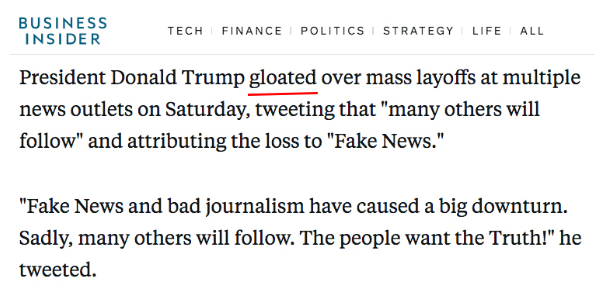
“Gloat” means “contemplate or dwell on one's own success or another's misfortune with smugness or malignant pleasure.” Is there evidence in Trump’s tweet to show he is being smug or taking pleasure in the layoffs, or is this a subjective interpretation?
Source article
Business Insider Bias Rating
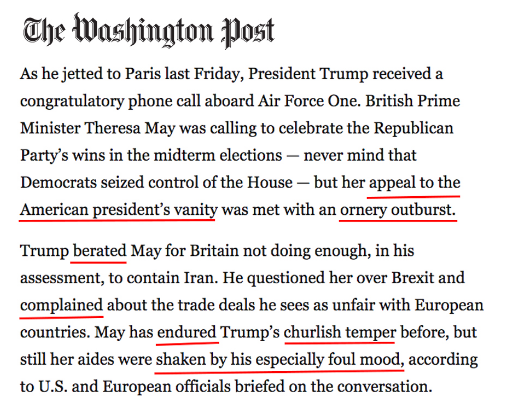
In this example of spin media bias, the Washington Post uses a variety of dramatic, sensationalist words to spin the story to make Trump appear emotional and unhinged. They also refer to the president's "vanity" without providing supporting evidence.
Washington Post Bias Rating
Top of Page
2. Unsubstantiated Claims
Journalists sometimes make claims in their reporting without including evidence to back them up. This can occur in the headline of an article, or in the body.
Statements that appear to be fact, but do not include specific evidence, are a key indication of this type of media bias.
Sometimes, websites or media outlets publish stories that are totally made up. This is often referred to as a type of fake news .
Examples of Unsubstantiated Claims Media Bias

In this media bias instance, The Daily Wire references a "longstanding pattern," but does not back this up with evidence.
The Daily Wire Bias Rating

In late January 2019, actor Jussie Smollett claimed he was attacked by two men who hurled racial and homophobic slurs. The Hill refers to “the violent attack” without using the word “alleged” or “allegations." The incident was revealed to be a hoax created by Smollett himself.
The Hill Bias Rating

This Washington Post columnist makes a claim about wealth distribution without noting where it came from. Who determined this number and how?
3. Opinion Statements Presented as Fact
Sometimes journalists use subjective language or statements under the guise of reporting objectively. Even when a media outlet presents an article as a factual and objective news piece, it may employ subjective statements or language.
A subjective statement is one that is based on personal opinions, assumptions, beliefs, tastes, preferences, or interpretations. It reflects how the writer views reality, what they presuppose to be the truth. It is a statement colored by their specific perspective or lens and cannot be verified using concrete facts and figures within the article.
There are objective modifiers — “blue” “old” “single-handedly” “statistically” “domestic” — for which the meaning can be verified. On the other hand, there are subjective modifiers — “suspicious,” “dangerous,” “extreme,” “dismissively,” “apparently” — which are a matter of interpretation.
Interpretation can present the same events as two very different incidents. For instance, a political protest in which people sat down in the middle of a street blocking traffic to draw attention to their cause can be described as “peaceful” and “productive,” or, others may describe it as “aggressive” and “disruptive.”
Examples of Words Signaling Subjective statements :
- Good/Better/Best
- Is considered to be
- May mean that
- Bad/Worse/Worst
- It's likely that
Source: Butte College Critical Thinking Tipsheet
An objective statement, on the other hand, is an observation of observable facts . It is not based on emotions or personal opinion and is based on empirical evidence — what is quantifiable and measurable.
It’s important to note that an objective statement may not actually be true. The following statements are objective statements, but can be verified as true or false:
Taipei 101 is the world's tallest building. Five plus four equals ten. There are nine planets in our solar system. Now, the first statement of fact is true (as of this writing); the other two are false. It is possible to verify the height of buildings and determine that Taipei 101 tops them all. It is possible to devise an experiment to demonstrate that five plus four does not equal ten or to use established criteria to determine whether Pluto is a planet.
Editorial reviews by AllSides found that some media outlets blur the line between subjective statements and objective statements, leading to potential confusion for readers, in two key ways that fall under this type of media bias :
- Including subjective statements in their writing and not attributing them to a source. (see Omission of Source Attribution )
- Placing opinion or editorial content on the homepage next to hard news, or otherwise not clearly marking opinion content as “opinion.”
Explore logical fallacies that are often used by opinion writers.
Examples of Opinion Statements Presented as Fact

The sub-headline Vox uses is an opinion statement — some people likely believe the lifting of the gas limit will strengthen the coal industry — but Vox included this statement in a piece not labeled “Opinion.”
Vox Bias Rating

In this article about Twitter CEO Elon Musk banning reporters, we can detect that the journalist is providing their personal opinion that Musk is making "arbitary" decisions by making note of the word "seemingly." Whether or not Musk's decisions are arbitrary is a matter of personal opinion and should be reserved for the opinion pages.
SFGate Rating

In this article about Hillary Clinton’s appearance on "The Late Show With Stephen Colbert," the author makes an assumption about Clinton’s motives and jumps to a subjective conclusion.
Fox News Bias Rating
4. Sensationalism/Emotionalism
Sensationalism is a type of media bias in which information is presented in a way that gives a shock or makes a deep impression. Often it gives readers a false sense of culmination, that all previous reporting has led to this ultimate story.
Sensationalist language is often dramatic, yet vague. It often involves hyperbole — at the expense of accuracy — or warping reality to mislead or provoke a strong reaction in the reader.
In recent years, some media outlets have been criticized for overusing the term “breaking” or “breaking news,” which historically was reserved for stories of deep impact or wide-scale importance.
With this type of media bias, reporters often increase the readability of their pieces using vivid verbs. But there are many verbs that are heavy with implications that can’t be objectively corroborated: “blast” “slam” “bury” “abuse” “destroy” “worry.”
Examples of Words and Phrases Used by the Media that Signal Sensationalism and Emotionalism:
- Embroiled in...
- Torrent of tweets
Examples of Sensationalism/Emotionalism Media Bias

“Gawk” means to stare or gape stupidly. Does AP’s language treat this event as serious and diplomatic, or as entertainment?
AP Bias Rating

Here, BBC uses sensationalism in the form of hyperbole, as the election is unlikely to involve bloodshed in the literal sense.
BBC Bias Rating
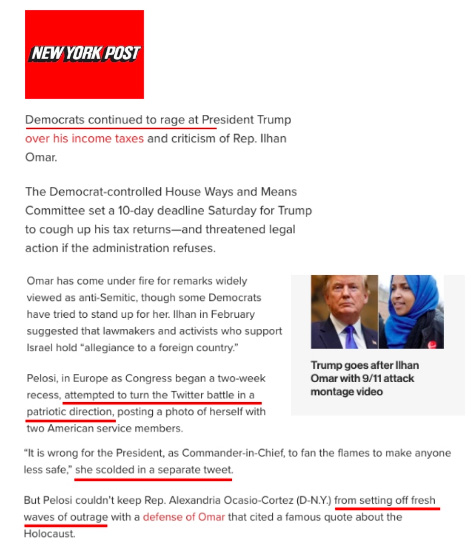
In this piece from the New York Post, the author uses multiple sensationalist phrases and emotional language to dramatize the “Twitter battle."
New York Post Bias Rating
5. Mudslinging/Ad Hominem
Mudslinging is a type of media bias when unfair or insulting things are said about someone in order to damage their reputation. Similarly, ad hominem (Latin for “to the person”) attacks are attacks on a person’s motive or character traits instead of the content of their argument or idea. Ad hominem attacks can be used overtly, or as a way to subtly discredit someone without having to engage with their argument.
Examples of Mudslinging
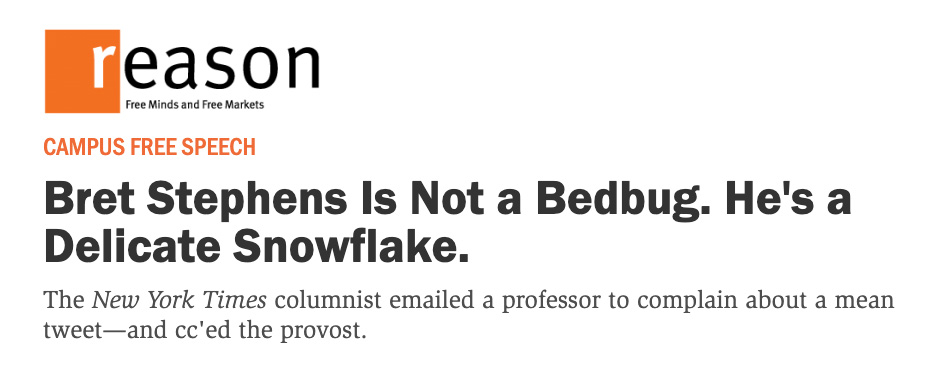
A Reason editor calls a New York Times columnist a "snowflake" after the columnist emailed a professor and his provost to complain about a tweet calling him a bedbug.
Reason Bias Rating

In March 2019, The Economist ran a piece describing political commentator and author Ben Shapiro as “alt-right.” Readers pointed out that Shapiro is Jewish (the alt-right is largely anti-Semitic) and has condemned the alt-right. The Economist issued a retraction and instead referred to Shapiro as a “radical conservative.”
Source: The Economist Twitter
6. Mind Reading
Mind reading is a type of media bias that occurs in journalism when a writer assumes they know what another person thinks, or thinks that the way they see the world reflects the way the world really is.
Examples of Mind Reading

We can’t objectively measure that Trump hates looking foolish, because we can’t read his mind or know what he is feeling. There is also no evidence provided to demonstrate that Democrats believe they have a winning hand.
CNN Bias Rating
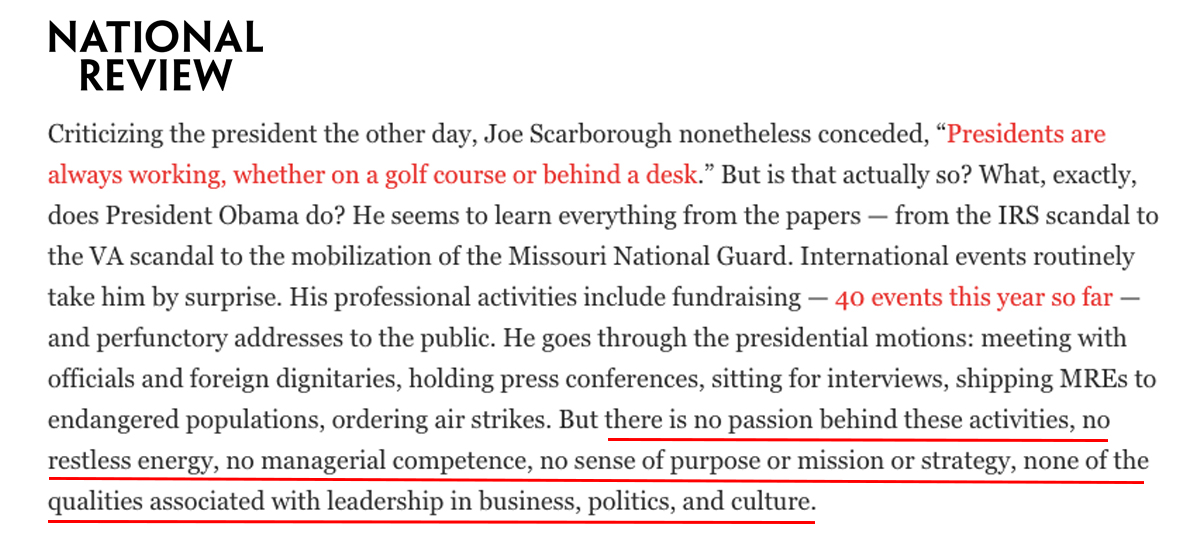
How do we know that Obama doesn’t have passion or sense of purpose? Here, the National Review writer assumes they know what is going on in Obama’s head.
National Review Bias Rating

Vox is upfront about the fact that they are interpreting what Neeson said. Yet this interpretation ran in a piece labeled objective news — not a piece in the Opinion section. Despite being overt about interpreting, by drifting away from what Neeson actually said, Vox is mind reading.
Slant is a type of media bias that describes when journalists tell only part of a story, or when they highlight, focus on, or play up one particular angle or piece of information. It can include cherry-picking information or data to support one side, or ignoring another perspective. Slant prevents readers from getting the full story, and narrows the scope of our understanding.
Examples of Slant
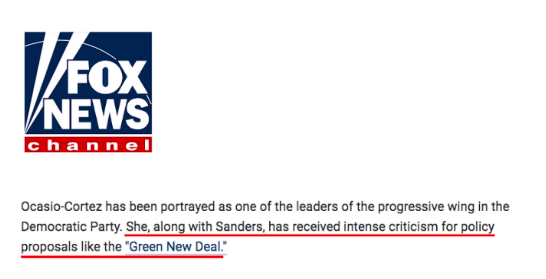
In the above example, Fox News notes that Rep. Alexandria Ocasio-Cortez’s policy proposals have received “intense criticism.” While this is true, it is only one side of the picture, as the Green New Deal was received well by other groups.
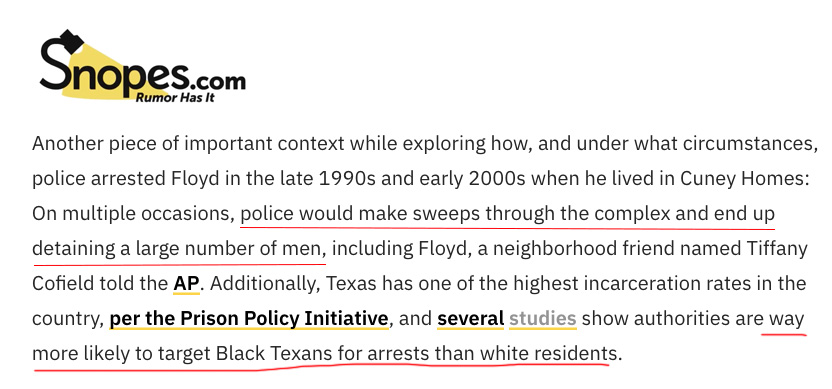
Here, Snopes does not indicate or investigate why police made sweeps (did they have evidence criminal activity was occurring in the complex?), nor did Snopes ask police for their justification, giving a one-sided view. In addition, the studies pointed to only show Black Americans are more likely to be arrested for drug possession, not all crimes.
Snopes Bias Rating
8. Flawed Logic
Flawed logic or faulty reasoning is a way to misrepresent people’s opinions or to arrive at conclusions that are not justified by the given evidence. Flawed logic can involve jumping to conclusions or arriving at a conclusion that doesn’t follow from the premise.
Examples of Flawed Logic

Here, the Daily Wire interprets a video to draw conclusions that aren’t clearly supported by the available evidence. The video shows Melania did not extend her hand to shake, but it could be because Clinton was too far away to reach, or perhaps there was no particular reason at all. By jumping to conclusions that this amounted to a “snub” or was the result of “bitterness” instead of limitations of physical reality or some other reason, The Daily Wire is engaging in flawed logic.
9. Bias by Omission
Bias by omission is a type of media bias in which media outlets choose not to cover certain stories, omit information that would support an alternative viewpoint, or omit voices and perspectives on the other side.
Media outlets sometimes omit stories in order to serve a political agenda. Sometimes, a story will only be covered by media outlets on a certain side of the political spectrum. Bias by omission also occurs when a reporter does not interview both sides of a story — for instance, interviewing only supporters of a bill, and not including perspectives against it.
Examples of Media Bias by Omission
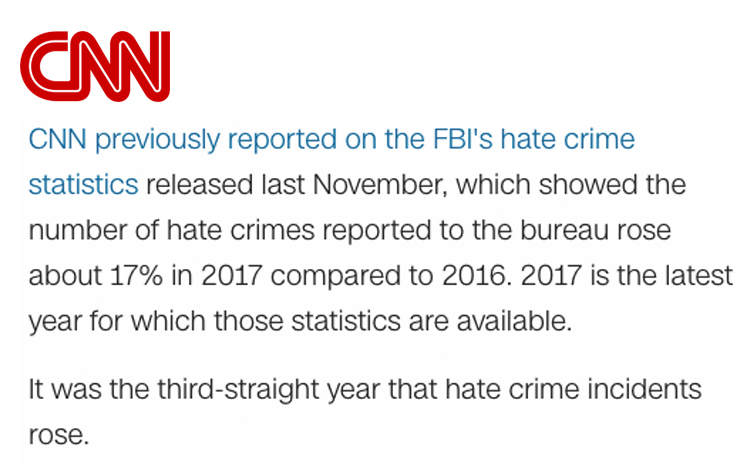
In a piece titled, "Hate crimes are rising, regardless of Jussie Smollett's case. Here's why," CNN claims that hate crime incidents rose for three years, but omits information that may lead the reader to different conclusions. According to the FBI’s website , reports of hate crime incidents rose from previous years, but so did the number of agencies reporting, “with approximately 1,000 additional agencies contributing information.” This makes it unclear whether hate crimes are actually on the rise, as the headline claims, or simply appear to be because more agencies are reporting.
10. Omission of Source Attribution
Omission of source attribution is when a journalist does not back up their claims by linking to the source of that information. An informative, balanced article should provide the background or context of a story, including naming sources (publishing “on-the-record” information).
For example, journalists will often mention "baseless claims," "debunked theories," or note someone "incorrectly stated" something without including background information or linking to another article that would reveal how they concluded the statement is false or debunked. Or, reporters will write that “immigration opponents say," "critics say," or “supporters of the bill noted” without identifying who these sources are.
It is sometimes useful or necessary to use anonymous sources, because insider information is only available if the reporter agrees to keep their identity secret. But responsible journalists should be aware and make it clear that they are offering second-hand information on sensitive matters. This fact doesn’t necessarily make the statements false, but it does make them less than reliable.
Examples of Media Bias by Omission of Source Attribution
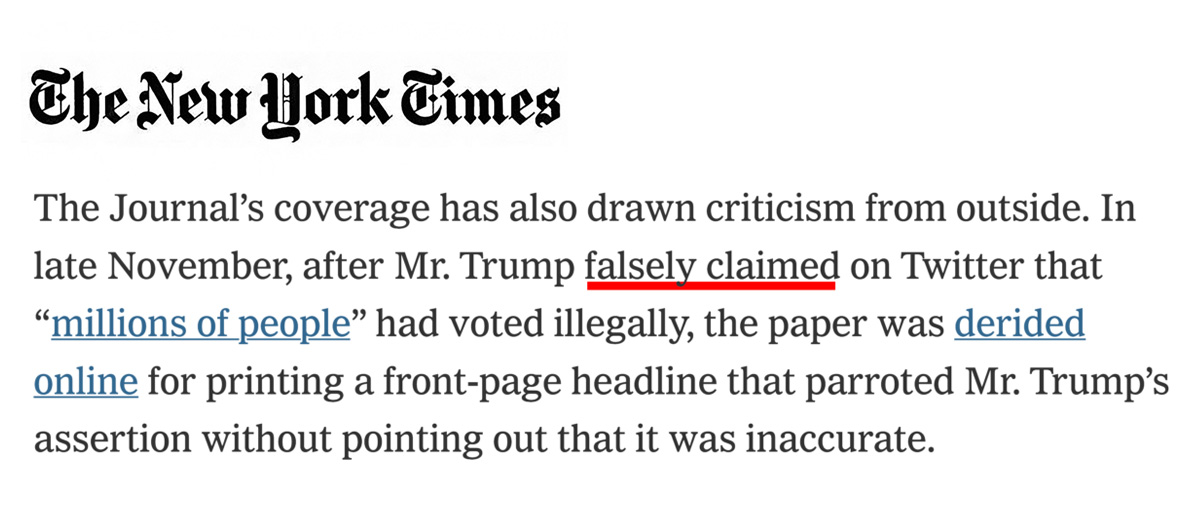
In this paragraph, The New York Times says Trump "falsely claimed" millions had voted illegally; they link to Trump's tweet, but not to a source of information that would allow the reader to determine Trump's claim is false.
The New York Times Bias Rating

In this paragraph, the Epoch Times repeatedly states "critics say" without attributing the views to anyone specific.
The Epoch Times Bias Rating
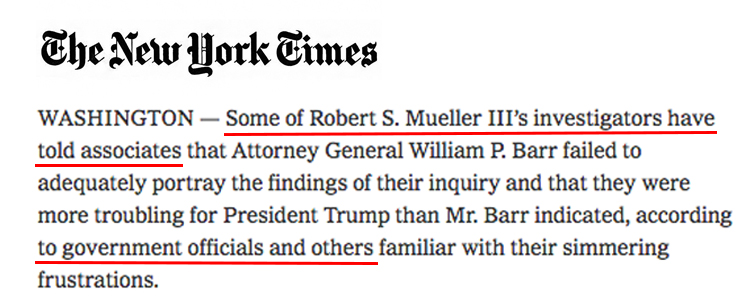
In a piece about the Mueller investigation, The New York Times never names the investigators, officials or associates mentioned.
11. Bias by Story Choice and Placement
Story choice, as well as story and viewpoint placement, can reveal media bias by showing which stories or viewpoints the editor finds most important.
Bias by story choice is when a media outlet's bias is revealed by which stories the outlet chooses to cover or to omit. For example, an outlet that chooses to cover the topic of climate change frequently can reveal a different political leaning than an outlet that chooses to cover stories about gun laws. The implication is that the outlet's editors and writers find certain topics more notable, meaningful, or important than others, which can tune us into the outlet's political bias or partisan agenda. Bias by story choice is closely linked to media bias by omission and slant .
Bias by story placement is one type of bias by placement. The stories that a media outlet features "above the fold" or prominently on its homepage and in print show which stories they really want you to read, even if you read nothing else on the site or in the publication. Many people will quickly scan a homepage or read only a headline, so the stories that are featured first can reveal what the editor hopes you take away or keep top of mind from that day.
Bias by viewpoint placement is a related type of bias by placement. This can often be seen in political stories. A balanced piece of journalism will include perspectives from both the left and the right in equal measure. If a story only features viewpoints from left-leaning sources and commentators, or includes them near the top of the story/in the first few paragraphs, and does not include right-leaning viewpoints, or buries them at the end of a story, this is an example of bias by viewpoint.
Examples of Media Bias by Placement
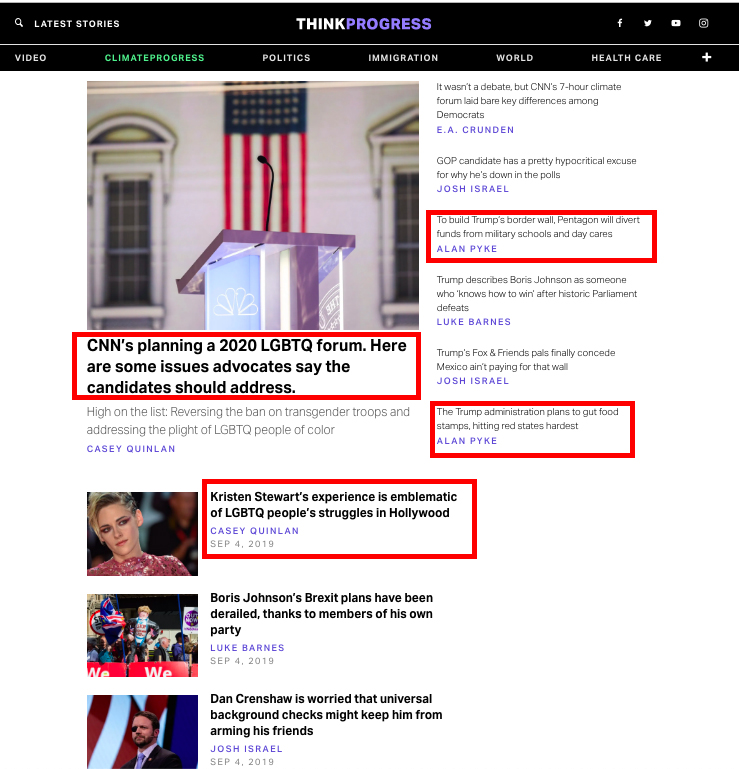
In this screenshot of ThinkProgress' homepage taken at 1 p.m. ET on Sept. 6, 2019, the media outlet chooses to prominently display coverage of LGBT issues and cuts to welfare and schools programs. In the next screenshot of The Epoch Times homepage taken at the same time on the same day, the outlet privileges very different stories.

Taken at the same time on the same day as the screenshot above, The Epoch Times chooses to prominently feature stories about a hurricane, the arrest of illegal immigrants , Hong Kong activists, and the building of the border wall. Notice that ThinkProgress' headline on the border wall focuses on diverting funds from schools and day cares, while the Epoch Times headline focuses on the wall's completion.
12. Subjective Qualifying Adjectives
Journalists can reveal bias when they include subjective, qualifying adjectives in front of specific words or phrases. Qualifying adjectives are words that characterize or attribute specific properties to a noun. When a journalist uses qualifying adjectives, they are suggesting a way for you to think about or interpret the issue, instead of just giving you the facts and letting you make judgements for yourself. This can manipulate your view. Subjective qualifiers are closely related to spin words and phrases , because they obscure the objective truth and insert subjectivity.
For example, a journalist who writes that a politician made a "serious allegation" is interpreting the weight of that allegation for you. An unbiased piece of writing would simply tell you what the allegation is, and allow you to make your own judgement call as to whether it is serious or not.
In opinion pieces, subjective adjectives are okay; they become a problem when they are inserted outside of the opinion pages and into hard news pieces.
Sometimes, the use of an adjective may be warranted, but journalists have to be careful in exercising their judgement. For instance, it may be warranted to call a Supreme Court ruling that overturned a major law a "landmark case." But often, adjectives are included in ways that not everyone may agree with; for instance, people who are in favor of limiting abortion would likely not agree with a journalist who characterizes new laws restricting the act as a "disturbing trend." Therefore, it's important to be aware of subjective qualifiers and adjectives so that you can be on alert and then decide for yourself whether it should be accepted or not. It is important to notice, question and challenge adjectives that journalists use.
Examples of Subjective Qualifying Adjectives
- disturbing rise
- serious accusations
- troubling trend
- sinister warning
- awkward flaw
- extreme law
- baseless claim
- debunked theory ( this phrase could coincide with bias by omission , if the journalist doesn't include information for you to determine why the theory is false. )
- critical bill
- offensive statement
- harsh rebuke
- extremist group
- far-right/far-left organization
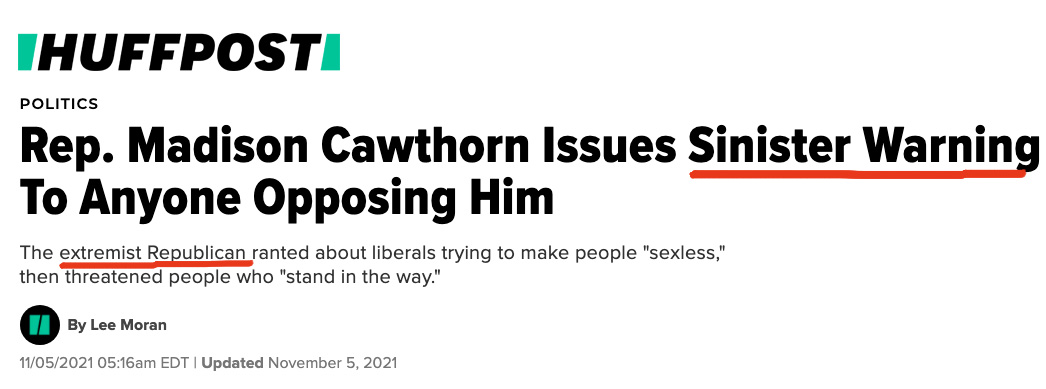
HuffPost's headline includes the phrases "sinister warning" and "extremist Republican." It goes on to note the politician's "wild rant" in a "frothy interview" and calls a competing network "far-right." These qualifying adjectives encourage the reader to think a certain way. A more neutral piece would have told the reader what Cawthorn said without telling the reader how to interpret it.
HuffPost bias rating
13. Word Choice
Words and phrases are loaded with political implications. The words or phrases a media outlet uses can reveal their perspective or ideology.
Liberals and conservatives often strongly disagree about the best way to describe hot-button issues. For example, a liberal journalist who favors abortion access may call it " reproductive healthcare ," or refer to supporters as " pro-choice ." Meanwhile, a conservative journalist would likely not use these terms — to them, this language softens an immoral or unjustifiable act. Instead, they may call people who favor abortion access " pro-abortion " rather than " pro-choice ."
Word choice can also reveal how journalists see the very same event very differently. For instance, one journalist may call an incident of civil unrest a " racial justice protest " to focus the readers' attention on the protesters' policy angles and advocacy; meanwhile, another journalist calls it a " riot " to focus readers' attention on looting and property destruction that occurred.
Words and their meanings are often shifting in the political landscape. The very same words and phrases can mean different things to different people. AllSides offers a Red Blue Translator to help readers understand how people on the left and right think and feel differently about the same words and phrases.
Examples of Polarizing Word Choices
- pro-choice | anti-choice
- pro-abortion | anti-abortion
- gun rights | gun control
- riot | protest
- illegal immigrants | migrants
- illegal alien | asylum-seeking migrants
- woman | birthing person
- voting rights | voting security
- sex reassignment surgery | gender-affirming care
- critical race theory | anti-racist education
Examples of Word Choice Bias
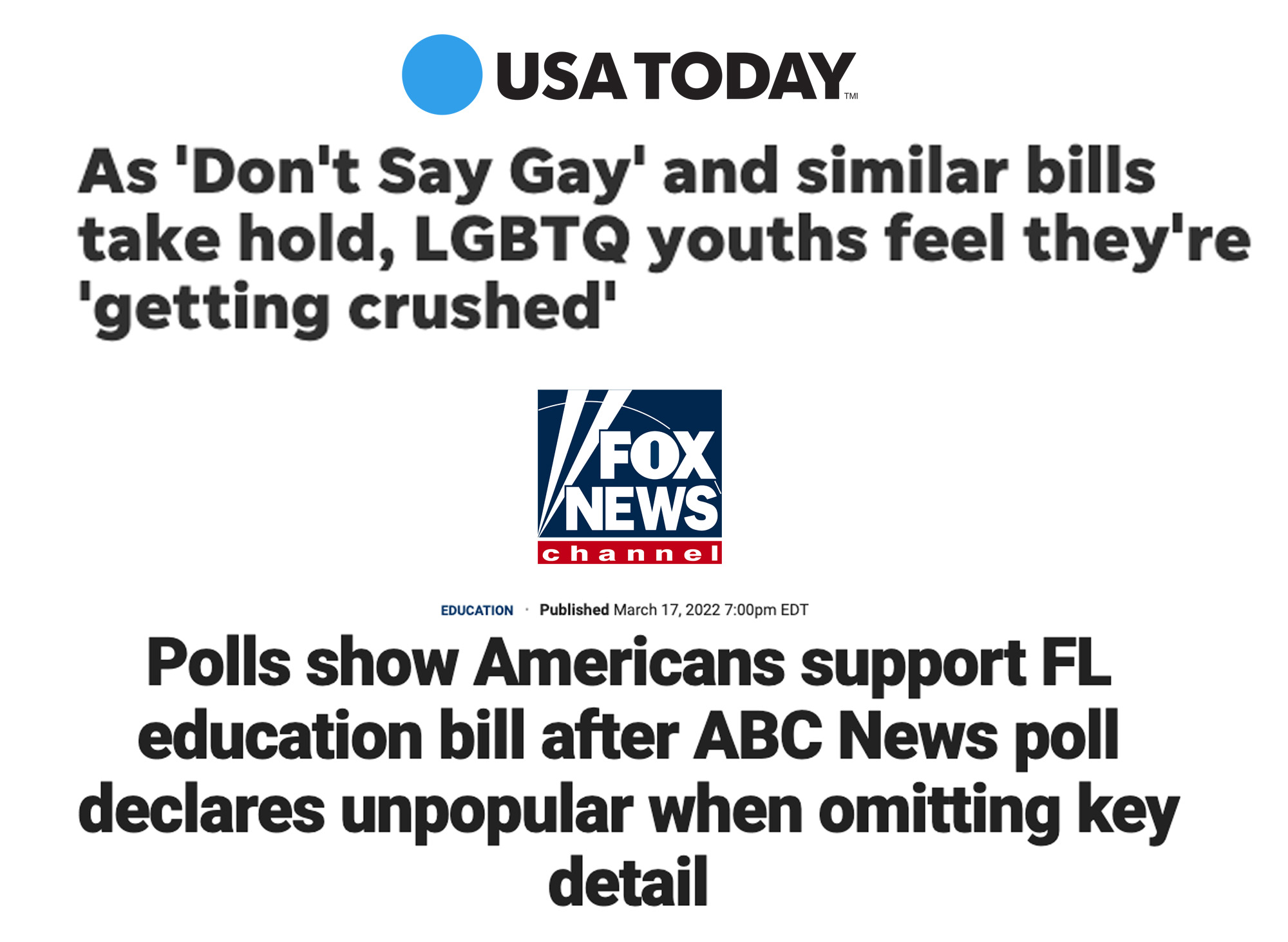
An outlet on the left calls Florida's controversial Parental Rights in Education law the "Don't Say Gay" bill, using language favored by opponents, while an outlet on the right calls the same bill the "FL education bill," signaling a supportive view.
USA Today source article
USA TODAY media bias rating
Fox News source article
Fox News media bias rating
14. Photo Bias
Photos can be used to shape the perception, emotions or takeaway a reader will have regarding a person or event. Sometimes a photo can give a hostile or favorable impression of the subject.
For example, a media outlet may use a photo of an event or rally that was taken at the very beginning of the event to give the impression that attendance was low. Or, they may only publish photos of conflict or a police presence at an event to make it seem violent and chaotic. Reporters may choose an image of a favored politician looking strong, determined or stately during a speech; if they disfavor him, they may choose a photo of him appearing to yell or look troubled during the same speech.
Examples of Photo Bias

Obama appears stern or angry — with his hand raised, brows furrowed, and mouth wide, it looks like maybe he’s yelling. The implication is that the news about the Obamacare ruling is something that would enrage Obama.
The Blaze bias rating

With a tense mouth, shifty eyes and head cocked to one side, Nunes looks guilty. The sensationalism in the headline aids in giving this impression (“neck-deep” in “scandal.”)
Mother Jones bias rating
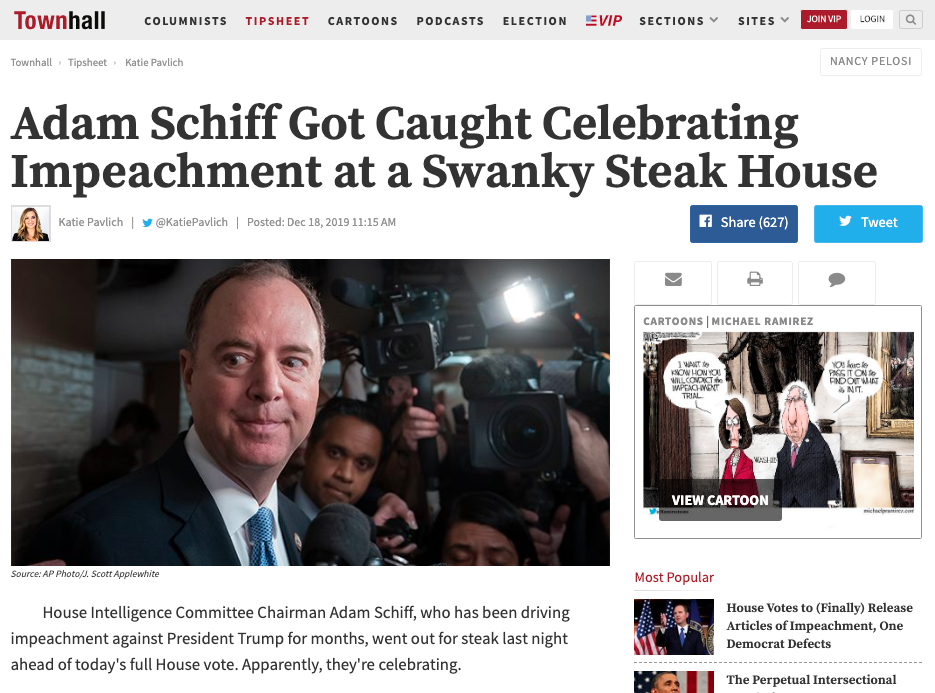
With his lips pursed and eyes darting to the side, Schiff looks guilty in this photo. The headline stating that he “got caught celebrating” also implies that he was doing something he shouldn’t be doing. Whether or not he was actually celebrating impeachment at this dinner is up for debate, but if you judged Townhall’s article by the photo, you may conclude he was.
Townhall bias rating

With his arms outreached and supporters cheering, Texas Gov. Greg Abbott appears triumphant in this photo. The article explains that a pediatric hospital in Texas announced it will stop performing “ gender-confirming therapies ” for children, following a directive from Abbott for the state to investigate whether such procedures on kids constituted child abuse. The implication of the headline and photo is that this is a victory.
The Daily Wire bias rating
15. Negativity Bias
Negativity bias refers to a type of bias in which reporters emphasize bad or negative news, or frame events in a negative light.
"If it bleeds, it leads" is a common media adage referring to negativity bias. Stories about death, violence, turmoil, struggle, and hardship tend to get spotlighted in the press, because these types of stories tend to get more attention and elicit more shock, outrage, fear, and cause us to become glued to the news, wanting to hear more.
Examples of Negativity Bias

This story frames labor force participation as a negative thing. However, if labor force participation remained low for a long time, that would also be written up as bad news.
New York Times bias rating
16. Elite v. Populist Bias
Elite bias is when journalists defer to the beliefs, viewpoints, and perspectives of people who are part of society's most prestigious, credentialed institutions — such as academic institutions, government agencies, business executives, or nonprofit organizations. Populist bias, on the other hand, is a bias in which the journalist defers to the perspectives, beliefs, or viewpoints of those who are outside of or dissent from prestigious institutions — such as "man on the street" stories, small business owners, less prestigious institutions, and people who live outside of major urban centers.
Elite/populist bias has a geographic component in the U.S. Because major institutions of power are concentrated in American coastal cities (which tend to vote blue), there can exist conflicting values, perspectives, and ideologies among “coastal elites” and “rural/middle America" (which tends to vote red). The extent to which journalists emphasize the perspectives of urbanites versus people living in small town/rural areas can show elite or populist bias, and thus, political bias.
Examples of Elite v. Populist Bias

Elite Bias: This article emphasizes the guidance and perspectives of major government agencies and professors at elite universities.
NBC News bias rating

Populist Bias: In this opinion piece, journalist Naomi Wolf pushes back against elite government agencies, saying they can't be trusted.
The Epoch Times bias rating
Everyone is biased. It is part of human nature to have perspectives, preferences, and prejudices. But sometimes, bias — especially media bias — can become invisible to us. This is why AllSides provides hundreds of media bias ratings and a media bias chart.
We are all biased toward things that show us in the right. We are biased toward information that confirms our existing beliefs. We are biased toward the people or information that supports us, makes us look good, and affirms our judgements and virtues. And we are biased toward the more moral choice of action — at least, that which seems moral to us.
Journalism as a profession is biased toward vibrant communication, timeliness, and providing audiences with a sense of the current moment — whether or not that sense is politically slanted. Editors are biased toward strong narrative, stunning photographs, pithy quotes, and powerful prose. Every aspiring journalist has encountered media bias — sometimes the hard way. If they stay in the profession, often it will be because they have incorporated the biases of their editor.
But sometimes, bias can manipulate and blind us. It can put important information and perspectives in the shadows and prevent us from getting the whole view. For this reason, there is not a single type of media bias that can’t, and shouldn’t occasionally, be isolated and examined. This is just as true for journalists as it is for their audiences.
Good reporting can shed valuable light on our biases — good and bad. By learning how to spot media bias, how it works, and how it might blind us, we can avoid being fooled by media bias and fake news . We can learn to identify and appreciate different perspectives — and ultimately, come to a more wholesome view.
Julie Mastrine | Director of Marketing and Media Bias Ratings, AllSides
Early Contributors and Editors (2018)
Jeff Nilsson | Saturday Evening Post
Sara Alhariri | Stossel TV
Kristine Sowers | Abridge News
IELTS test format explained
Test takers who understand the format of IELTS are at an advantage. Make sure you’re familiar with how IELTS testing works.
There are two IELTS tests available, IELTS Academic and IELTS General Training . Both tests are graded in exactly the same way.
You’ll take the first three parts of the test on the same day, in the following order: Listening, Reading and Writing (there are no breaks between these tests). Your Speaking test will be held either on the same day or seven days before or after that, depending on local arrangements.
The IELTS Listening test is designed to assess a wide range of listening skills, including how well you:
- understand main ideas and specific factual information
- recognise the opinions, attitudes and purpose of a speaker
- follow the development of an argument.
Take a free listening practice test.
You will need to read quickly and efficiently, and manage your time. You will be asked to read three different passages and respond to related questions in your IELTS Reading test. The content of the Reading test is different for IELTS Academic and IELTS General Training tests.
The IELTS Reading test is designed to assess a wide range of reading skills, including how well you:
- read for the general sense of a passage
- read for the main ideas
- read for detail
- understand inferences and implied meaning
- recognise a writer’s opinions, attitudes and purpose
Academic Reading
general training reading.
Take a free reading practice test.
The IELTS Writing test is designed to assess a wide range of writing skills, including how well you:
- write a response appropriately
- organise ideas
- use a range of vocabulary and grammar accurately.
Academic Writing
General training writing.
Take a free writing practice test.
You will talk to a certified examiner in the IELTS Speaking test. The test is interactive and as close to a real-life situation as a test can get. A variety of accents may be used, and the test will be recorded.
The content of the IELTS Speaking test is the same for both the IELTS Academic and IELTS General Training tests.
The IELTS Speaking test is designed to assess a wide range of skills.
The examiner will want to see how well you can:
- communicate opinions and information on everyday topics and common experiences; to do this you will need to answer a range of questions
- speak at length on a given topic using appropriate language
- organise your ideas coherently
- express and justify your opinions
- analyse, discuss and speculate about issues.
Make sure that you relax and talk fluently. You will need to speak naturally.
Take a free speaking practice test.
Video call Speaking test
Many IELTS test centres will start delivering the IELTS Speaking test via video calls. This means more flexibility and more availability of IELTS Speaking tests.
You will take the video call Speaking test at an official IELTS test centre with the same high standard of identity verification. The test will be exactly the same as the in-person Speaking test in terms of content, scoring, timing, level of difficulty, question format and security arrangements. Delivered by an IELTS Speaking Examiner, the video call Speaking test will maintain the face-to-face feature of the in-person Speaking test.
For more information, please contact us .

Get notified in your email when a new post is published to this blog
Visual Studio Blog
The official source of product insight from the Visual Studio Engineering Team
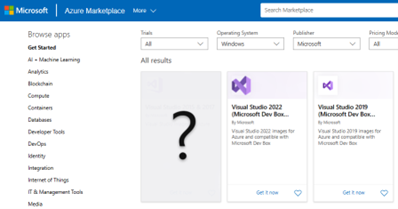
Giving our Azure marketplace images a makeover
Get Hands-On with Visual Studio and Azure: Live at Microsoft HQ this August!
Introducing the Revamped Visual Studio Resource Explorer
A modern Extension Manager has arrived with Visual Studio 17.10
VisualStudio.Extensibility 17.10: Debug your extensions with the Diagnostics Explorer

Developing cloud-native apps with .NET Aspire and Visual Studio
First preview of Visual Studio 2022 v17.11
Maximizing joy and minimizing toil with great developer experiences
Visual Studio 2022 17.10 and GitHub Copilot: Your Coding Partner for Faster and Smarter Development
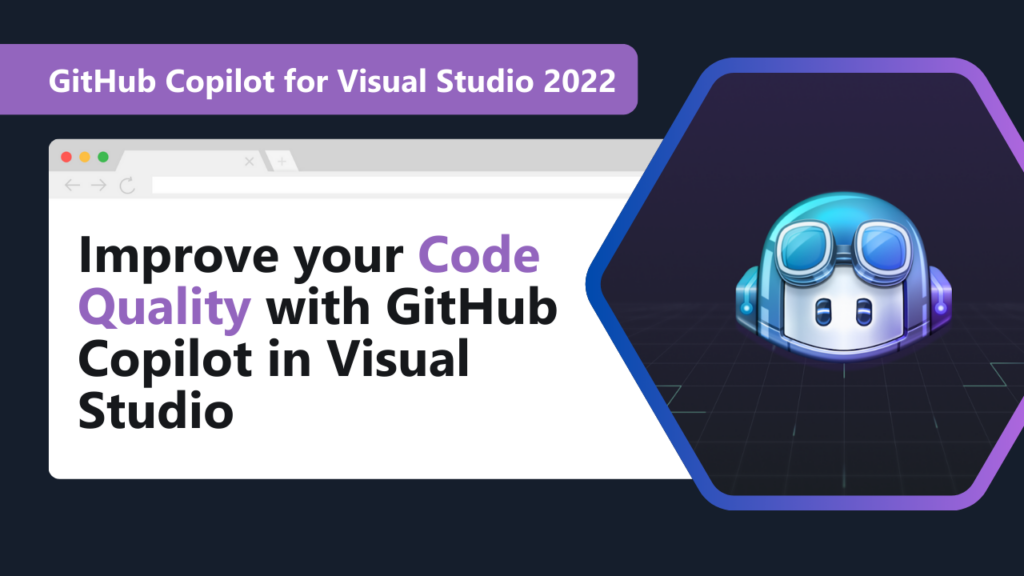
Improve your code quality with GitHub Copilot in Visual Studio

IMAGES
VIDEO
COMMENTS
An essay is a focused piece of writing designed to inform or persuade. There are many different types of essay, but they are often defined in four categories: argumentative, expository, narrative, and descriptive essays. Argumentative and expository essays are focused on conveying information and making clear points, while narrative and ...
Whether you're a first-time high school essay writer or a professional writer about to tackle another research paper, you'll need to understand the fundamentals of essay writing before you put pen to paper and write your first sentence. ... Writing 101: The 8 Common Types of Essays. Written by MasterClass. Last updated: Jun 7, 2021 • 3 ...
1. Expository Essays. These are most likely the types of essays you may encounter and the standard essay style needed for exams. When writing an expository essay, you will go deeper into a subject or issue to develop an idea, analyze supporting data, and then organize an "exposition" on the concept.
There are four main types of essays: argumentative, expository, narrative, and descriptive. Each type of essay has its own unique characteristics and is written for a different purpose. Understanding the different types of essays is essential for writing a successful essay.
AI Tools to enhance your academic writing. SciSpace Copilot - AI research assistant. Literature Review. Paraphraser. AI Detector. Citation Generator. Academic writing includes different types of essays for students. This article gives a short summary of the 7 types of essays you often find in academic writing.
Definition of Types of Essay. An essay is a short academic composition. The word "essay" is derived from a French word "essai" or "essayer," which mean "trail." In composition, however, an essay is a piece of non-fiction writing that talks or discusses a specific topic.Presently, essay is part of every degree program.
Though you're likely not to encounter every single type of essay that exists, sometimes it's necessary to know about them. Learn about 15 different types here.
This video will cover the 4 main types of essays: narrative, descriptive, expository, and argumentative. We'll explain the key features and provide tips for ...
An essay is a paper that discusses, describes or analyzes one topic. It can discuss a subject directly or indirectly, seriously or humorously. It can describe personal opinions, or just report information. An essay can be written from any perspective, but essays are most commonly written in the first person (I), or third person (subjects that can be substituted with the he, she, it, or they ...
Types of essays. At Sheridan, you are likely to come across four types of essays. Each essay types has different requirements and produces different outcomes. In this section, you will find descriptions of the four essay types: Expository, Argumentative or Persuasive, Reflective, and Descriptive.
Expository Essay. An expository essay is used as a way to look into a problem and therefore compare it and explore it. For the expository essay there is a little bit of storytelling involved but this type of essay goes beyond that. The main idea is that it should explain an idea giving information and explanation.
paragraph 2. Topic sentence outlining second argument. Sentences giving explanations and providing evidence to back topic sentence. Concluding sentence - link to next paragraph. Following body paragraphs. These follow the same structure for as many arguments as you wish to put forward in support of the topic. Conclusion.
An essay is a highly versatile, non-fictional piece of writing aimed at persuading, informing, or entertaining the reader. It can serve multiple functions, such as taking a stance on topics, disproving widely believed myths, and sharing interesting anecdotes. There are various styles and types of essay writing that can be used to serve specific functions.
Here are 10 types of essays you may use in your writing: 1. Narrative essays Narrative essays tell a story and often are the most personal type of essay you may write. They allow you to exercise creativity and imagination, and you can base them on a particular prompt, such as the first time you drove a car by yourself, or a more open-ended ...
Expository Essay. Informative Writing, Research, Clarity. Explain the causes and effects of climate change, and discuss its impact on the environment and society. Narrative Essay. Storytelling, Narrative Structure, Engagement. Describe a memorable childhood event that had a significant impact on your life.
Every essay is different. But we can identify four common types of essay: Expository essays (i.e., essays that explain something) Descriptive essays (i.e., essays that describe something) Persuasive essays (i.e., essays that aim to persuade the reader) Narrative essays (i.e., essays that tell a story)
The types of essays you'll write in college or university are as follows: Admissions Essay. Argumentative Essay. Cause and effect Essay. Scholarship Essay. Persuasive Essay. Explanatory Essay. Theory of Knowledge Essay. Thematic Essay.
4 Make a specific point. Determine what the purpose of your essay is. State that point in your thesis statement, or controlling idea, and build upon it throughout the essay by using examples, stories, and other details that all relate back to the main idea. 4 Involve readers in the story and create a visual picture by using dialogue and ...
The three types of essay most commonly assigned in school — the narrative essay, the persuasive essay, and the expository essay — conveniently correspond to those writing forms most frequently published online and in print. Your experience with these prose forms is ideal preparation for writing for publication. 1. The Narrative Essay.
The Bad. Common admissions wisdom has advocated that students should avoid the 3 D's — Death, Divorce and Drugs. The Death Essay is unfortunately more common than we all would like. Don't think I'm heartless, but it's very difficult for high school students to say much more than this special person had a tremendous influence and now ...
Which of the 4 different essay types you should use depends largely on the assignment or desired outcome. Expository Essay. An expository essay gives a brief explanation of an issue, idea or theme.Purdue OWL expands on this, offering some common requirements in step form: investigation of an idea, evaluation of evidence, a systematic and detailed explanation of the idea, and a clear and ...
An essay is a highly versatile, non-fictional piece of writing aimed at persuading, informing, or entertaining the reader. It can serve multiple functions, such as taking a stance on topics, disproving widely believed myths, and sharing interesting anecdotes. There are various styles and types of essay writing that can be used to serve specific functions.
The Online Writing Lab at Purdue University houses writing resources and instructional material, and we provide these as a free service of the Writing Lab at Purdue. Students, members of the community, and users worldwide will find information to assist with many writing projects. Teachers and trainers may use this material for in-class and out ...
No sentence is complete without a punctuation mark! Learn about the common types of punctuation marks & typographical symbols and how to use them.
1. Spin. Spin is a type of media bias that means vague, dramatic or sensational language. When journalists put a "spin" on a story, they stray from objective, measurable facts. Spin is a form of media bias that clouds a reader's view, preventing them from getting a precise take on what happened.
Task types: Two tasks: Task 1 and Task 2. You will be asked to write at least 150 words for Task 1 and at least 250 words for Task 2. Marks: Your Writing test will be marked by a certificated IELTS examiner. Task 2 is worth twice as much as Task 1 in the IELTS Writing test. Scores are reported in whole and half bands.
Communicators of all types can use the symbol to communicate serenity, harmony, unity and the absence of violence. 3 Butterfly. All over the world, in both myth and art, the butterfly is seen as a symbol of transformation and change, thanks to its metamorphosis from a wormy caterpillar to a stunning insect with vividly colored wings.
We are excited to announce the release of Visual Studio 2022 v17.11 Preview 1, the first preview of our next update for Visual Studio 2022. This preview focuses on quality-of-life improvements for all developers and workloads. See the release notes for full list of features. (image) When you use Visual Studio, you want to feel empowered...